INDEPENDENT PRACTITIONER TODAY
The business journal for doctors in private practice
Proof that it works
The register of verified practitioners of non-surgical cosmetic care is going through a face-lift P10


Sloping



Proof that it works
The register of verified practitioners of non-surgical cosmetic care is going through a face-lift P10


Sloping


By Robin Stride
Independent practitioners who recently received an NHS Clinical Excellence Award (CEA) have been shocked to discover the reward could land them with a substantial tax burden.
This is because any increase in pensionable pay may force them to unwittingly breach the annual allowance rate – which is the total amount which can be paid into a pension each year before attracting a tax charge.
The annual allowance was chopped to just £40,000 a year in April 2014 and advisers are warning that most senior doctors will find they will breach this rate by the yearly rise in NHS Pension benefits alone, before even considering the impact of private pension contributions.
And things will only get worse next month for many hundreds of higher-income doctors with a private practice.
From April 2016, individuals earning over £150,000 will see their annual allowance reduced even more. It will drop by £1 for every £2 of income with a maximum reduction of £30,000 for those earning £210,000 or more.
Consultants heard of the CEA bombshell at Independent Practitioner Today’ s pay and pensions seminar last month, hosted by the Royal Society of Medicine.

Simon Bruce, managing director of financial advisers Caven dish Medical, explained later: ‘The Clinical Excellence Award is a worthy reward for an outstanding contribution to the profession. However, you might be disappointed to hear that your achievement could mean paying significantly more tax.
‘Your new CEA will be backdated to April 2015. Unfortunately, this means you may only find out if you are liable for a tax charge long after your tax records for 2015-16 have been submitted.
‘The NHS Pensions Agency will probably not write to those breach-


ing the annual allowance cap until this autumn – and, sadly, little can then be done retrospectively.’
Cavendish Medical has been receiving a steady stream of inquiries from senior doctors who are worried about their position.
There were 318 new CEA awards in 2015 and 319 the year before. Nearly everyone with a national award and private practice earnings is likely to be affected, although Cavendish said this depended on many factors.
Mr Bruce told Independent Practitioner Today: ‘It may be possible to use your allowances from the last three years – known as “carry for-
ward” – but the exact financial position and the implications for your tax status can only be ascertained with detailed analysis.
‘If you are not confident of your own position, you should seek help without delay. Remember, the onus will be on the individual to notify HM Revenue and Customs if you are liable for a tax charge.’
BMA private practice committee chairman Mr Derek Machin said: ‘The recent changes in NHS pensions and the Government’s ongoing meddling with lifetime allowances, annual allowances and tax relief on pensions is causing problems to many doctors.’




a big boost for sports medicine
the ground-breaking manchester institute of health and performance has opened P8
who’s driving your bus? is your business running you? here’s how you can get back in the driving seat P14
checking private doctors’ quality
Specialists are being asked to check data about their work before it’s published P29
Perfect partners
a legal outlook on becoming a member of a limited liablity partnership P32
Try not to panic
When looking a investments’ performance, it is best to keep a cool head P36
To hire or to buy?
our resident accountant answers the big question: to lease or buy equipment? P50
our regular columns
Dilemmas:

So imagine you can just go to work in private practice, do the job you were trained for and go home.
No worries about your business, no problems with staff, no defence fees to pay and your paperwork reduced at a stroke.
Those might be among the pluses for any consultant opting for a salaried service if these job opportunities begin emerging in independent hospitals here as they have in the US.
We have written before about the possible pros and cons of being a somewhat less than independent private practitioner.
What is interesting now is to
Consultants in Kent have been told they can secure private treatment theatre slots during sociable hours when the £30m One Ashford hospital opens this month.
The hospital, funded by Octopus Healthcare and operated by One Healthcare, says it will focus primarily on private healthcare and limit the amount of NHS work.
Over 80 consultants with practising privileges have been told the operational model will enable them to grow their practice and fill their regular lists, while avoiding delays and unsociable hours.
Australasian Treatment Centre methodology and its systems were designed to maximise efficiency in the care pathway and enhance patient outcomes.
A unique online booking facility allows all patients to book a named consultant, physiotherapy session or radiology appointment online within 90 seconds, regardless of whether they are self-pay or insured.
hear that more established leading consultants are actually asking their private hospitals: ‘How about you employ me?’ Managers who had not even thought of the possibility find themselves now looking at the idea much more closely.
The subject had a good airing among doctors we spoke to at Independent Practitioner Today’s ‘Your fees, your pension – your future’ joint event with the Royal Society of Medicine last month.
And it will surely crop up again at the BMA private practice conference on 6 April. Do pop along to our stand and tell us what you think.
Tell us your news Editorial director Robin Stride at robin@ip-today.co.uk Phone: 07909 997340 @robinstride

To adverTise Contact advertising manager Margaret Floate at margifloate@btinternet.com Phone: 01483 824094
To subscribe lisa@marketingcentre.co.uk Phone 01752 312140
Publisher: Gillian Nineham at gill@ip-today.co.uk Phone: 07767 353897
Head of design: Jonathan Anstee chief sub-editor: Vincent Dawe 12,450 circulation figures verified by the Audit Bureau of Circulations ediTorial commenT
One Healthcare chief executive Adrian Stevenson said local consultants had struggled to get regular daytime theatre slots during the week due to high NHS volumes.
‘To address this, one of One Ashford’s theatres will be dedicated to ad hoc private work for two days each week, providing consultants with the opportunity to access theatre slots at a time that suits them and their patients, avoiding any bottlenecks elsewhere.’
The hospital said its operational model was based on US and
Mr Stevenson said the company was committed to delivering a new approach to private healthcare that provided excellent patient experience while supporting consultants’ commercial requirements and work-life balance goals.
One Ashford has three theatres, 20 patient rooms, ten ambulatory care pods, ten consulting rooms, three procedure rooms, digital X-ray facilities, static MRI and a full physiotherapy suite.
The hospital is the first in a series of private healthcare facilities planned by One Healthcare, established 21 months ago, with a second hospital already underway in Hertfordshire.

by robin stride
HCA is spearheading a new initiative to improve quality for patients by fostering stronger relationships between the private hospital sector and the NHS.
After hosting 90 leading figures from across the healthcare spectrum for an inaugural conference, entitled ‘A Question of Quality’, it now hopes to build on the ‘talking shop’ at future events.
The group’s chief executive Dr Chris Streather and Manisha Shah, executive director and vice president of clinical services and patient
safety, expressed the hope the event would spark more collaboration and partnerships to improve quality. They told delegates: ‘By joining the dots from across sectors and across the globe, we can deliver better outcomes for patients.’
The group, with joint NHS ventures in London, Manchester and Essex, expects to announce another outside the capital shortly.
HCA Healthcare UK’s president and chief executive Mike Neeb said it was trying to provide a network of facilities in local areas: ‘The key to improving quality is collaboration.’
The meeting brought together leading clinicians, independent sector providers, NHS partners, researchers, regulators, thinktanks and industry stakeholders.
They heard presentations from experts in patient safety and advocates for best practice, including Dr Jonathan Perlin, HCA’s chief medical officer in Nashville, Tennessee, and Prof Sir Liam Donaldson, the World Health Organisation’s patient safety envoy.
The former CMO for England underlined the need for strong responses to weak signals of failure. Sir Liam said he found many
hospitals on his travels thought bad events could not happen to them – an attitude at odds with those in other industries.
Sir Robert Naylor, chief executive of University College London Hospitals NHS Foundation Trust, stressed that if quality was not at the top of an organisation, then it would aim for mediocrity.
He welcomed moves to publish more quality data in the private sector, saying the more this happened, the more would be learned from it.
See ‘Offer from private sector to help NHS’ on page 4
The Royal College of Surgeons of Edinburgh has claimed ‘a significant victory for patient safety and robust science’ following vigorous lobbying, which led to MPs voting against plans that could have exposed patients to unethical, experimental treatments.
Under the Access to Medical Treatments (Innovation) Bill, the speed and scope of medical innovation in England and Wales would increase.
But its proposed methods to achieve this outcome were based on the suggestion that litigation, or the fear of litigation, was significantly deterring medical professionals from trying new drugs and treatments – an idea not supported by evidence or practice.
Measures within the bill would have allowed doctors to ‘depart from the existing range of accepted medical treatments as long as they obtained the view of another doctor’.
The college said this would have significantly loosened the current checks and balances on untested and unproven treatments, which protect both patients and doctors.
RCSEd said it worked extensively with MPs to raise concerns over the potential effects on patient safety, and it co-ordinated activity with medical charities and other royal colleges to ensure these were raised as loudly as possible.
Following extensive lobbying, MP Mr Chris Heaton-Harris, who introduced the Bill to Parliament, asked
that the sections of the bill which would have undermined the current robust system be removed.
RCSEd president Michael Lavelle Jones said: ‘I am delighted that Mr Heaton-Harris and other MPs have listened to our real concerns and dropped these unwanted and unnecessary clauses.
‘There remains precious little evidence that litigation deters clinicians from trying new treatments. The existing legal and ethical framework provides clear guidance to clinicians, and undermining this framework would have presented a significant threat to patient safety.’
He said he was grateful for the support the college received from MPs from all parties.

The RCSEd still has reservations over a proposed Database of Innovations and the possible impacts this might have on quality and sound medical practice.
‘Check your data’, private doctors urged
Consultants in private practice will soon be invited to check data about their work before it is published to the public.
And in an appeal to Independent Practitioner Today readers this month, the boss of the Private Healthcare Information Network (PHIN) has asked them to engage with the process.
Chief executive Matt James fore-
casted ‘a transformational year’ ahead for private healthcare.
He said: ‘We have already seen a tranche of changes in how the sector operates following the Competition and Markets Authority’s (CMA) Private Healthcare Investigation Order 2014.
‘Consultants working in private practice are acutely aware of the new rules around accepting pri -
vate hospital incentives, which have placed additional pressure on their practice. Now there are more changes they need to be aware of and engaged in’.
PHIN will be collecting aggregated information on performance measures, including the number of procedures, patient satisfaction, and adverse events. These will be publically availa-
ble to help patients make decisions when choosing a consultant and facility for their treatment.
Mr James said: ‘We know many consultants and hospitals are feeling the pressure brought about by these changes. But I believe while the changes brought about by the CMA order are significant, they are also necessary.’
See his detailed report on p29
By a staff reporter
HCA’s The Harley Street Clinic has become the first hospital in the UK to offer innovative brain surgery using a ROSA robot – enabling neurosurgeons to carry out precise, targeted and minimally invasive brain surgery.
Using a kind of GPS system, the machine will allow London Neurosurgery Partnership consultants to navigate difficulttoreach areas of the brain and allow surgical planning based on patient images.
The robotic arm of the ROSA has been designed to mimic human arm actions, giving surgeons greater flexibility and freedom of movement when operating.
London Neurosurgery Partnership’s Prof Keyoumars Ashkan said: ‘For decades, the ability to reach deep brain locations and doing so in an accurate, precise and safe manner has presented neurosurgeons with significant challenges.
‘This is particularly so when treating patients with brain
Stretched NHS facilities should look to private healthcare for more support, according to the independent hospitals’ trade body.
The Association of Independent Healthcare Organisations’ chief executive Fiona Booth welcomed last month’s Carter Review into productivity in English acute hospitals and said the body looked forward to continuing to work alongside the NHS for patients’ benefit.
Ms Booth said: ‘With Britain experiencing increasing demand for healthcare, everyone involved should be looking to strengthen the relationship between the NHS and the independent sector in
order to make sure patients can access highquality, timely care at good value to the public purse.
‘The Carter Review’s drive for efficiency and providing the best quality of care to patients is welcome, and the NHS and its partners should look to work more collaboratively with the independent sector.’
Independent hospitals have more than 9,100 overnight beds which the NHS could use.
Ms Booth added: ‘Especially when the NHS is stretched, it should look to the independent sector for support. Not only do we provide excellent care for patients but we do so at no additional cost to the taxpayer.’
Nuada Urology hosted an educational event at 19 Harley Street, bringing together GPs, clinicians and healthcare organisations to meet its team of urologists who presented on their research and clinical practice.

aida yousefi of the harley street Clinic
The video presentations are available at: www.nuadagroup. com/blog/post.php?s=201602 12
nuada
urology
team
presentonadvancesinmriprostatecancerdiagnosisandtreatmentlutsandpostsurgerycare
tumours, epilepsy or when performing deep brain stimulation for movement disorders.
‘Various approaches have been devised to address these difficulties with varying success. The ROSA robot is designed to exactly address these unmet needs and in a much more efficient manner than we have been able to do thus far.’
He said the reduced operative time using the robot would likely mean safer surgery, less time under anesthetic and lower infection risk.
The Harley Street Clinic chief executive Aida Yousefi said: ‘We are delighted to be the first hospital in the UK to offer the ROSA system to our patients.’
London Neurosurgery Partnership has 11 subspecialist consultant neurosurgeons who work as a multidisciplinary team to offer the full spectrum of neurosurgical expertise to treat patients with brain and spine disease.
The ROSA robot is designed by MEDTECH, a European specialist in the development and marketing of innovative robotic appliances to assist surgeons.
Healthcare cash plan provider Medicash has hit back at claims by Chancellor George Osborne that his hike in insurance pre
mium tax on healthcare insur
ance only brings the UK into line with Europe.
Medicash points out that, of 29 EU countries, 12 of them exempt healthcare from the tax and three more do not apply it at all.
The provider, running an ongoing campaign against the tax, said only six had insurance premium tax on healthcare above 6%: Belgium (9.25%), France (9%), Greece (10%), Slovenia (6.5%), Slovakia (9.5%) and the UK (9.5%).
Chief executive Sue Weir said: ‘Firms in the UK need to realise that this tax puts them at a disadvantage in terms of growth and profits and the health and wellbeing of their employees if they are unable to cover the rise in providing health insurance for those employees.
‘By putting the UK at a tax disadvantage to Europe, the high level of insurance premium tax will impact negatively on UK business productivity and both the physical and mental health of our employees.’
By Charles King
London’s private hospital theatre capacity is tipped to rise by around 10% this year as more small ‘super specialty’ clinics become operational.
The developments are down to a new breed of small, highly specialised providers, according to a report from healthcare analyst LaingBuisson.
And operators adopting these ‘new models of care’ could be a challenge to incumbent providers as they seek to build brand awareness and take greater control of the patient pathway, suggests the company’s updated analysis
Private Acute Medical Care in Central London
Report author Ted Townsend believes the move towards ‘superspecialty’ clinics could be seen as a product of the growing central London trend towards high acuity care.

He said: ‘For some years, private hospitals in central London have been moving up the complex care trajectory and the emergence of superspecialties is taking that to another level as groups of consultants get together to offer highly specialised services.
‘By focusing on the whole care pathway, these companies are effectively cutting out the hospi
tal. They can provide the consultations, the diagnostics, including imaging, and the surgery, meaning that they can make money from the whole patient journey rather than just their consultant fees.’
Mr Townsend said clinicians have always operated independently in London’s Harley Street area, but what made the new operators different was their level of management expertise and their concept of brand identity.
He added: ‘In the past, what you had were basically cottage industries versus large hospital opera
the Cleveland Clinic has taken a long-term lease on a 198,000ft2 building in london’s Grosvenor place.
uae-based healthcare giant Vps healthcare plans a 150-bed cancer centre on the former royal masonic hospital site in hammersmith.
Circle plans to open a proton beam therapy centre in harley street in a joint venture with advanced oncotherapy.
spire is still looking for a london site but has told independent practitioner today there is ‘no truth’ in consultants’ rumours of a
planned development at the earls Court exhibition centre.
there is permission in the earls Court master plan for a private hospital and a health centre.
Fortius Clinic, the trading name of the london orthopaedic and sports medicine Centre, is opening two new sites this year – a 12,000ft2 diagnostic and treatment centre in King William street, City of london, and a three-theatre surgical centre in Bentinck street.
nuada medical Group – originally prostate
tors, but these new providers are bringing in management skills to work alongside clinical expertise. So far, the challenge to the existing general hospital is small, but the trend towards day surgery means that, for a lot of specialties, you don’t need a full service hospital.’
He said he expected that more smaller providers would deliver high acuity care over the next five years in the less capitalintensive specialties.
LaingBuisson’s Private Acute Medical Care in Central London – 2nd edition, starts at £1,175 for an individual package (hard copy and PDF/Excel files for use by one person). Go to www. laingbuisson.co.uk
cancer specialists but now focused on gynaecology and urology – will open a twotheatre site on harley street next year.
laingBuisson said: ‘although the company’s model differs from Fortius in that it is looking to expand the number of specialties it offers under the nuada brand, it is also a consultantowned business that sets out to cover the full care pathway.’
the new optegra eye hospital in Queen anne st opened at the end of December with two operating theatres and 11 overnight beds.
Medical defence body MDDUS is reminding doctors to be aware of the recently introduced mandatory duty to report cases of female genital mutilation (FGM) in girls under 18.
The introduction of the Serious Crime Act in October 2015 means doctors in England and Wales now have a legal obligation to report to police cases of FGM in girls under the age of 18.
It is estimated that approximately 60,000 girls aged 0 to 14 living in the UK are potentially at risk. FGM has been illegal in the UK since 1985.
MDDUS medical adviser Dr Barry Parker said doctors should follow GMC ethical guidance by raising concerns with an appropriate safeguarding agency so that prompt action can be taken.
He said: ‘If a girl under the age of 18 discloses that she has undergone FGM, or has physical signs of having had FGM in the past, then there is now a legal requirement in England and Wales to report the matter to the police.
‘Reporting should take place as soon as possible and certainly within a month of the initial disclosure or finding. Failure to do so
is itself a breach of a doctor’s statutory duty.’
But the mandatory duty to report to police did not apply if a parent, guardian, sibling or other individual disclosed that a girl under 18 has had FGM, or where a doctor considered the girl to be at risk of FGM. Here doctors should follow local safeguarding procedures and adhere to GMC guidance on child protection.
Dr Parker continued: ‘For patients aged 18 or over, the Department of Health advises that local safeguarding procedures should be followed and patients
should be made aware of services offering support. A safeguarding risk assessment may also be required for any other children in the family who may be at risk.’
Doctors who report FGM would not be held to have breached confidentiality or any other restriction on the disclosure of information, but it was advisable to explain to the girl and/or her family why a report was being made, unless this would risk serious harm to anyone.
He advised doctors to contact their defence body with any concerns.
See feature article on page 18
By a staff reporter
Members of the British Association of Aesthetic Plastic Surgeons (BAAPS) were chosen to perform cosmetic surgery by a record number of Britons last year.
They recorded a 13% rise in operations given to patients in 2015 from 2014 – to 51,000 –with all procedures seeing an increase in demand.
Former BAAPS president Mr Rajiv Grover said: ‘We represent 4050% of cosmetic surgery in the country – perhaps the growth is because people are choosing us and electing to go with the surgeons who have transparent qualifications.
‘What people are looking for is to go through this journey – and it is a journey – with one person holding their hand all the way, and that’s easier when you go to an individual surgeon rather than a clinic.’
Another factor in the rise could be a small increase in BAAPS membership, which rose from 225 to 230.
Surgeons said it was also possible that patients were encouraged by positive reports and attractive results of cosmetic surgery among ‘A’list celebrities.
It is believed new attitudes could be one of the drivers for increased acceptance and destigmatising of aesthetic enhancement.
Seven out of ten of the most popular procedures saw a doubledigit increase.
Women’s cosmetic surgery rose 12.5% from 2014. Breast augmentation remained the most popular procedure (up 12%).
But BAAPS members said the oversized ‘glamour model’ or artificial look once associated with implants had all but vanished and they saw patients now opting for smaller sizes for a more
natural, proportionate enhancement.
The association suggested some of the most dramatic rises – face/ neck lifts (up 16%) and liposuction (up 20%) – could be linked to the fact that despite the vast array of nonsurgical treatments hyped for these areas in recent years, the public were realising they had limited effect when compared to traditional surgery.
Men underwent substantially more facial procedures, with face/ necklifts climbing 14%, brow lifts (+15.5%), eyelid surgery(+15%), and rhinoplasty (+14%) all gaining more popularity.
Although men still account for just 9% of the total number of cosmetic surgery operations in the UK, their numbers have nearly doubled over the past decade – from 2,440 procedures in 2005 to 4,614 in 2015.
Mr Grover said: ‘The doubledigit rise in surgical procedures suggests that the public are choosing to spend on treatments with a proven track record, such as facelifts and liposuction, which remain as the gold standard for facial rejuvenation and body contouring.
‘The plethora of new noninvasive methods for skin tightening and cellulite that are here today and gone tomorrow often appear too good to be true and fail to make the cut.’
He added that both genders seemed encouraged by ‘a new openness’ in glamorous celebrities admitting they have had ‘a little surgical help’ to enhance their looks.
‘There is a danger, however, that this presents the image of cosmetic surgery as a commodity, so the public must always be warned that an operation is not something that can simply be returned to the shop if you don’t like it.’

ThE ToP SURGICAL PRoCEDURES FoR MEN AND WoMEN IN 2015
Total 51,140: a rise of 12.6% from 2014
In order of popularity:
3,261 – up 3%
ThE ToP SURGICAL PRoCEDURES FoR WoMEN IN 2015
Total 46,526: a rise of 12.5% from 2014
Women had 91% of all cosmetic procedures in 2015
In order of popularity:
Breast augmentation 9,642 – up 12% from last year
Blepharoplasty (eyelid
– up 14%
– up 3%
– up 8%
Browlift 1,946 – up 6%
otoplasty (ear correction) 53 – up 15%
ThE ToP SURGICAL PRoCEDURES FoR MEN IN 2015
Total 4,614: a rise of 13.5% from 2014.
Men had 9% of all cosmetic procedures in 2015
In order of popularity:
Blepharoplasty (eyelid surgery) 976 – up 15% from last year
Rhinoplasty 812 – up 14%
Breast reduction 796 – up 13%
Liposuction 586 – up 20%
otoplasty (ear correction) 521 – up 13%
Face/neck lift 372 – up 14%
Fat transfer 260 – up 8%
Brow lifts 164 – up 15.5%
Abdominoplasty 117 – up 11%
Breast augmentation 10 – static
By Edie Bourne
If you are a private doctor whose practice is getting inspected by the Care Quality Commission (CQC), what is it like in the runup to a visit?
Harrowing to say the least, if results from a survey of NHS GPs are anything to go by.
A BMA study of 1,900 practices in England went as far as to say that the CQC inspection regime is damaging frontline patient care by diverting resources and GP
time away from treating patients.
The association has called for the scrapping of planned CQC inspection fee rises, claiming they are ‘extortionate’ and a drain on precious NHS resources.
Key findings from the survey include:
80% of GP practices reported that preparing for a CQC inspection resulted in a reduction in time available to care for patients;
70% had to pay for staff overtime while preparing for inspections and 30% had to employ locums;
87% said staff had to reduce services on the day of the CQC inspection; 75% reported that staff suffered from significantly increased stress in preparing for and undergoing inspections;
Only 11% regarded their final CQC rating as fair.
BMA GP committee chairman Dr Chaand Nagpaul claimed the current CQC inspection regime was not fit for purpose and needed wholesale reform that produced an effective, slimmeddown pro
cess focusing on ensuring a safe, effective service.
A special policymaking conference of GPs subsequently voted for their leaders to actively campaign to abolish CQC regulation of general practice
They also backed a motion to explore all options enabling GP practices to legally withdraw from CQC engagement.
☞ What is your experience of CQC inspection in private practice? Email robin@ip-today. co.uk
Private doctors could save Disclosure Barring Service (DBS) check hassle by subscribing to a special service, says the Independent Doctors Federation (IDF).
Martha Walker, its independent adviser on CQC issues, said: ‘We are encouraging all doctors to make use of the DBS update service, which enables providers to see the current DBS status of any doctor at any given time.
‘This stops the long wait for a DBS check. You get an instant answer of people’s DBS status and it is also cheaper than undergoing a brand-new DBS.'
An annual subscription for the www.gov.uk/dbs-update-service is £13.
As Independent Practitioner Today reported last month, a huge backlog in DBS applications in London has raised fears for clinics seeking CQC registration.
KIMS independent hospital in Maidstone, Kent, has won a healthy workplace award and a workplace ‘wellbeing charter’, under a healthy business scheme backed by the local borough and county councils.
There are three levels of award and KIMS said it would work towards the highest excellence level, achieved in part by the launch of its new healthy workplace scheme.
The 99 bed hospital, used by
200 consultants, ran a range of launch day activities for staff during their breaks, including:
Riding a smoothie bike;
Smoking cessation;
Personal trainer;
Travel adviser & health checks;
Beautician and masseur.
Chief executive Simon James said: ‘It is really important to not only encourage staff to be healthy, but to give them the opportunity and the support to make lifestyle changes.’






Proton Partners International Ltd has won planning permission to build the first proton beam therapy clinic to be opened in England. The planning application is for the specialised extension and remodelling of the Earth Balance wellness site at West Sleekburn Farm, Northumberland. Proton’s chief executive Mike Moran said by placing the centre in Northumberland, close to transport links, it could cater to a wider group of people in the north of England and Scotland. There are currently no operational proton therapy facilities in the UK. Proton Partners will also be opening a centre in Newport where work is already underway, plus a third centre in London.
Independent practitioners are working under ever increasing burdens of regulation and financial pressures, according to BMA private practice committee chairman Mr Derek Machin. He hopes the speaker lineup for the association’s private practice conference on 6 April at BMA House, London, will help ease the load.
Mr Machin told Independent Practitioner Today: ‘We will be hearing from Dr Andrew VallanceOwen about the information requirements imposed by the Competition and Markets Authority and how the Private Healthcare Information Network will be collecting the data and the consultants’ role in verifying their data.
‘Increases in medical indemnity costs are a worry to all private practitioners and we will be having a presentation from Paul Mackin of MPS.
‘The issues around medical insurers and hospitals are not being forgotten and we are delighted to have Julian Stainton, chief executive of the Western
Provident Association, and JeanJacques de Gorter of the Spire Healthcare Group, addressing the conference.’
Another theme will be maintaining your income in the runup to retirement.
Details and booking: www.bma. org.uk/events/2016/april/privatepracticeconference
The new ground-breaking Manchester Institute of Health and Performance has opened its doors. Leslie Berry reports
A pioneering new facility – the first of its kind in the UK – is set to revolutionise health and sports performance in g reater Manchester.
The £18m purpose built unit has been designed to create a worldclass environment for diagnosis, education and research in health and performance.
The institute, the result of six years of planning and research, is made up by a partnership team of Manchester City Council, Sport england – which invested lottery funding into the project – and City Football group.
HCA Healthcare UK, with a track record in delivering highquality healthcare in the region, has been brought on board to operate the facility, which includes:
Treatment and rehab rooms;
3T Mri imaging & ultrasound;
Ultrasound;
Xray and DeXA scanners;
3D performance capture hall;
Cryotherapy suite;
environmental chamber;
Strength and conditioning gym;
Hydrotherapy;
physiology lab;
Biomechanics lab;
Lecture theatre;
Seminar rooms.
The Manchester i nstitute of Health & performance will deliver programmes for the local community, amateur and grass roots sports, as well as for elite athletes. it will be supported by consultants, sports injury specialists, nurses, physiotherapists and healthcare researchers.
To support local young talented sportspeople, Manchester City Council, Sport e ngland and the institute are now funding a project to help them achieve their fullest potential.
An academy programme will give grassroots athletes access to leaders in sport, exercise and health, as well as cutting edge equipment.
opportunity
Would suit doctor(s) with interest/experience in providing doctors appraisals in the independent sector. Established network of designated bodies/appraisers with large database of doctor clients. Very high turnover and profit, with 35% annual growth. Massive potential for additional development. Please email your contact details for more information and confidential discussion to:

The institute aims to deepen collaboration and best practice across sport disciplines, to en hance physical performance and to provide sport development programmes for elite athletes.
Top clubs supporting the centre include Manchester City FC, Manchester City women’s Football Club, and an ever growing group of elite athletes based in east Manchester such as British Cycling, gB para Swimming, gB Taekwondo and e nglish Squash and racket Ball.
The institute also has a public health agenda that will help to investigate health and physical activity across greater Manchester
as part of the city’s public health strategy.
Key areas of work include collaborative research exploring heart disease, diabetes and obesity with local universities, as well as a facility for self pay or insured patients affected by, but not limited to, sportsrelated injuries.
i nstitute director Dr Stephen Mcgregor paid tribute to the ‘outstanding team work and local support’ received by the project over the last six years.
Lesley Taylor, HCA Healthcare UK chief executive of the north, said the company was excited to be part of the project, which would bring real benefits to the local community.
The hospital group believes the

The institute also has a public health agenda that will help to investigate health and physical activity across Greater Manchester as part of the city’s public health strategy

pods (above) and an environmental chamber that can test performance in the cold
form part of the institute’s enviable scientific and research as well as sporting facilities

facility will greatly improve the health and lives of people across Manchester as well as providing ground breaking research and diagnostics, delivered by leading consultants, nurses, physiotherapists and healthcare researchers.
Sir r ichard Leese, Manchester City Council leader, said: ‘The facility joins a wealth of world
renowned centres that have built an enviable collection of sport and leisure services designed for all levels of ability. This has long been a key motivator for the major regeneration programme in east Manchester – with sport and leisure at its core – to increase participation and help support athletes from grassroots through to elite level.’


Treatments You Can Trust, the register of verified practitioners of non-surgical cosmetic interventions, has been going through a face lift. Sally Taber reports
Aesthetic doctors are being offered a new service from treatments You c an trust ( t Y ct ) –data collection about treatments.
i f you are a doctor who uses injectable cosmetics in your practice, this is important news.
As sir Bruce Keogh reported in 2013, nonsurgical cosmetic intervention is largely a ‘data free zone’. Very little about the practice of non surgical cosmetic interventions has been numerated. that is what is behind our new programme.
We will shortly offer innovative clinics an opportunity to join in the scheme, which we anticipate will soon bring benefits to participants. Public anonymity for data is builtin, of course.
Another important development for doctors is the release by h ealth e ducation e ngland of Qualification requirements for delivery of cosmetic procedures: Nonsurgical cosmetic interventions and hair restoration surgery. 1
By setting out very high levels of education and qualifications for practitioners of cosmetic nonsurgical treatments, it will help to lever away those who should not be practising in this area.
it places doctors in a commanding position in the aesthetic industry and so sets the standard the public should be able to expect.
But as hee requirements will not be mandatory until 2018, there is need for aesthetic doctors in the meantime to join together to reclaim their unique position in public trust.
the collected data will produce, in time, evidence to drive improvements in clinical practice, patient education, innovation and research. it will help potential patients compare and choose which clinician to consult, and

that must surely work in favour of properly qualified doctors practising aesthetic medicine. our new partner in this change is Northgate Public services (NPs)2 who have noted skills in data collection and analysis and already host a number of registers including the National Joint register.
NP s initially was a partner in the Private h ealthcare i nformation Network (PhiN),3 approved by the competition and Markets Authority as ‘the i nformation organisation with a mandate to ensure that patients using private healthcare can expect far better information to help them compare and choose’.
We will be giving enhanced status to clinics that already collect treatment data and perceive benefits from it.
tYct will be inviting selected clinics to join in this new venture. Members of the British college of Aesthetic Medicine and the independent doctors Federation, who have lots of members who are innovative leaders in aesthetic medicine, would be welcome participants.
Aesthetic doctors might be tempted to rely on GMc registration to foment public trust. But aesthetic medicine is not the Nhs; there are many less qualified out there competing for the business.
Meanwhile, the public is confused, often judging by cost rather
than safe practitioners. But i believe joining the tYct register of verified practitioners lifts you clear of the mass and the public are assured of your credentials. if you display our quality mark, then it is a reassurance to the public and they will seek you out because of it. A £500 joining fee is money well spent.
tYct has been verifying injectable cosmetic treatment providers since 2010, when its originator, independent healthcare Advisory s ervices, produced the original and unique standards for injectable c osmetic treatment 4 and associated training Principles.5 the standards have withstood the test of time, still translating the quality requirements of the professional regulators, the h ealth and s afety Act 1973 section 3, the Medicines Act and Advertising standards Authority into actionable guidelines for providers of injectable cosmetics.
You will, no doubt, remember that the GM c set out its Good Medical Practice (2013), 6 which includes a number of requirements for those practising injectable cosmetics. t he t Y ct standards are referenced to them. however, the remit of the system regulators (the care Quality commission in england) does not run to non surgical cosmetic interventions, which is the reason for the tYct register.
t his is the trustworthy inde

pendent verification of credentials which the public needs if it is to grow in trust of those properly educated and trained in a field where there are too many who are not. Joining tYct is a step in the right direction for every doctor. i n another innovation, t Y ct will form a register of aesthetic laser users.
Lasers for cosmetic interventions are precariously unregulated. in alliance with the British Medical Laser Association, tYct has updated its Essential Standards Class 3B and Class 4 Lasers and Intense Light Systems in non-surgical applications, which have been in use by many local authorities for several years for the registration of laserusing clinics.
it is our ambition to bring the same standard of rigorous verification used for cosmetic injectables to verification of credentials of laser clinics and, indeed, a similar level of clinical audit too.
We are well on the way to making the tYct register the veritable gold standard for a doctor who is driving improvements in clinical practice, patient education, innovation and research.
Sally Taber is director of Treatments You Can Trust
1. https://hee.nhs.uk/news-events/news/ new-qualifications-unveiled-improvesafety-non-surgical-cosmetic-procedures
2. www.northgatepublicservices.co.uk
3. www.phin.org.uk/Home.aspx
4. www.treatmentsyoucantrust.org.uk/ tyct-standards-for-injectable-cosmetictreatments
5. In conjunction with the professional regulators, regulatory agencies of the DoH and industry representatives
6. www.gmc-uk.org/guidance/good_ medical_practice.asp



Are you really doing the job you do best? That you enjoy most?
For 18 years we’ve helped large and small healthcare organisations across the world transform, grow, and improve the way they manage their businesses. Making your life better. And your patients.



While you concentrate on caring for your patients, our role is to help remove the yoke of management.
Not just the day-to-day logistics, but strategically, short and long term. Over the years we’ve transformed and grown countless practices and business. Planning and developing medical facilities. Marketing your healthcare services professionally, by knowing and employing the technology and media that deliver results.


Our teams are tailored to your needs. And if those needs change, so does our team. We have crisis management experts available 24 x 7. We combine clinical expertise with commercial sense and experience. We see the full picture, providing support when and where you need it most.
We work with both public and private sector healthcare providers. Our case histories in operations management, clinical advice, consultancy and development are outstanding.
To give it a thorough examination, call Peter Goddard on +44 (0)203 356 9699 or mobile +44 (0)780 314 4954
www.worldwidehealthcare.co.uk
Next month sees the start of the 2016-17 tax year. So what changes are afoot and what should you be doing? Susan Hutter gives some tips for getting ahead
From 6 April 2016, the annual allowance – which is effectively the maximum contribution payable into a pension scheme – is being reduced for those whose income is over £150,000.
As Independent Practitioner Today has also previously reported, the annual allowance up to 5 April is £40,000, including effective contributions into the NHS Pension Scheme.
The £40,000 will be reduced for every £2 of income over £150,000 to a minimum of £10,000 annual allowance.
For those who operate via a limited company and whose spouses are employed by it, the company can make an employer’s contribution into a pension scheme for the spouse as well as for themselves.
This is useful if the consultant’s own annual allowance is being reduced and they wish to pay more than their maximum into a pension scheme.
Also on 6 April, the lifetime allowance is being reduced from £1.25m to £1m.
This could have quite a serious tax effect and therefore for those who are on or around this limit, and definitely for those consultants who have superannuation schemes as well as a private pension scheme, it is worth taking advice about these changes.
The workplace pension contribution payable by employers was going to be increased by 1% dur-

ing this tax year. However, in the Autumn Statement last November, the staging date for this increase was delayed from October 2016 to 6 April 2017.
This is good news for those consultants who employ staff either via a company or otherwise, as it means there is a real saving of 1% of the gross salary that is paid to staff. It is better than nothing.
For consultants who invest in individual savings accounts (ISAs), you may wish to maximise the 2015-16 investment, which is £15,240.
As I write, we will have to wait until the Budget on 16 March to find out how much the increase will be in April 2016.
The maximum can be made up of cash, stocks and shares or a mixture of the two. If you do not pay up to the maximum, then you will lose the balance.
As far as Premium Bonds are concerned, the current maximum is £50,000 per person. Remember, with Premium Bonds there is a
chance of winning £1m every month.
The minimum prize is £25 and the general rate of return for those on the maximum is about 1.25%.
It is not fantastic, but bearing in mind that bank deposit accounts are not really better and that it is tax-free, it is quite a good deal for higher-rate taxpayers.
Also there is no risk with Premium Bonds; if you get fed up with not winning £1m, you can cash them in at no loss.
For those that are higher-rate taxpayers and who have a spouse that is not a higher-rate taxpayer, it is worth considering transferring income-earning investment assets to the spouse.
If bank interest is being received, although basic-rate tax is being deducted at source, higher-rate tax will be payable in addition.
One can obviously save this if the spouse is not a higher-rate taxpayer and therefore it is worth making the transfer. There are no tax implications of transferring money between spouses.
There was an interesting development in the Chancellor’s Autumn 2015 Statement on the payment date of Capital Gains Tax on the profit on a residential property, which is not one’s own home.
Although the changes are not coming in until April 2019, it is worthwhile taking some time to look at this, as, after that, the Capital Gains Tax will have to be paid within 30 days of completion of the sale.
This is a far less generous time period than is currently the case, whereby Capital Gains Tax does not have to be paid until 31 January following the end of the tax year in which the sale was made.
So it is important to ensure your records are up to date, showing:
The original cost of the property;
Legal and agents’ fees on the purchase of the property;
Capital costs of work done to the prope rty; for instance, new kitchen, bathrooms or extension.
If you do not have the relevant information to hand, it is worth looking for it now so that you will be able to comply with the 30-day rule in a few years time.
As in all cases with financial planning, it is worth taking advice sooner rather than later.
Susan Hutter (right) is a partner at specialist medical accountants
Shelley Stock Hutter


ESMYA® is the first medical treatment for the long-term management of moderate to severe symptoms of uterine fibroids.1

O Licensed for intermittent use1
O Fast, reliable and sustained control of bleeding2
O Significant and sustained reductions in fibroid volume from baseline2
O Improved quality of life compared to baseline2 O Well-tolerated2
PRESCRIBING INFORMATION
Esmya (ulipristal acetate) Please refer to the SmPC before prescribing. Presentation: 5mg tablet. Indication: Pre-operative or intermittent treatment of moderate to severe symptoms of uterine fibroids in adult women of reproductive age. Dose and administration: One tablet of 5mg to be taken orally once a day for a maximum of 3 months, starting during first week of menstrual cycle. This 3 month treatment course can be repeated. Re-treatment courses should start at the earliest during the first week of the second menstruation following the previous treatment course completion. Each treatment course should not exceed 3 months. Treatment free intervals are required between courses. Repeated intermittent treatment has been studied for up to 4 intermittent treatment courses. Please refer to SmPC for missed dose information. Patients with renal or hepatic impairment: No dose adjustment in mild to moderate renal impairment or mild hepatic impairment. Not recommended for patients with severe renal impairment and moderate or severe hepatic impairment unless patient is closely monitored. Children and adolescent under 18 years: No relevant use. Contraindications: Pregnancy, Breastfeeding, Genital bleeding of unknown aetiology. Uterine, Cervical, Ovarian or Breast cancer. Hypersensitivity to active substance or any excipients. Pregnancy and lactation: Contraindicated during pregnancy and lactation. Warnings and Precautions: Should only be prescribed after careful diagnosis and pregnancy should be precluded prior to treatment. Use in women with severe asthma insufficiently controlled by oral glucocorticoids is not recommended. Concomitant use of hormonal contraceptives are not recommended hence a non-hormonal contraceptive method should be used. Reversible histological changes of the endometrium: ‘Progesterone Receptor Modulator Associated Endometrial Changes’ (PAEC) may be observed in patients. Also, reversible thickening of the
endometrium may occur during treatment. If it persists beyond 3 months following the end of treatment and return of menstruations, and/or an altered bleeding pattern is noted, this may need to be investigated as per usual clinical practice. Please refer to SmPC for further details on endometrial changes and management of the same. In case of repeated intermittent treatment, periodic monitoring of the endometrium is recommended. This includes an annual ultrasound to be performed after resumption of menstruation during off-treatment period. Treatment leads to significant reduction in menstrual blood loss within 10 days and patients should notify their physician if heavy bleeding persists. Drug interactions: Hormonal contraceptives and progestogens are likely to reduce the efficacy of ulipristal acetate by competitive action on progesterone receptors, hence co-administration is not recommended. Not recommended for patients receiving moderate or potent CYP3A4 inhibitors or potent CYP3A4 inducers (e.g. rifampicin, carbamazepine, phenytoin, St John’s wort). Co-administration of P-gp substrates (e.g. dabigatran etexilate, digoxin) should be separated in time by at least 1.5 hours. Undesirable effects: The following adverse reactions have been reported during first treatment courses: Very Common (>1/10) Amenorrhea, Endometrial thickening; Common (>1/100 to <1/10) Headache, Vertigo, Abdominal pain, Nausea, Acne, Musculoskeletal pain, Hot flush, Pelvic pain, Ovarian cyst, Breast tenderness/pain, Fatigue, Weight gain.; Uncommon (>1/1000 to <1/100) Anxiety, Emotional disorder, Dizziness, Dry mouth, Constipation, Alopecia, Dry skin, Hyperhidrosis, Back pain, Urinary incontinence, Uterine haemorrhage, Metrorrhagia, Genital discharge, Breast discomfort, Oedema, Asthenia, Increase in cholesterol level Increased triglycerides, Rare (≥1/10,000 to <1/1,000) Epistaxis, Dyspepsia, Flatulence, Rupture of ovarian cyst, Breast swelling. When comparing repeated treatment courses, overall adverse reaction rates were less frequent in subsequent
treatment courses than during the first one and each adverse reaction was less frequent or remained in the same frequency category (except dyspepsia which was classified as uncommon). Overdose: Limited experience. Single doses of up to 200mg and daily doses of 50mg for 10 consecutive days administered to a limited number of subjects, and no severe or serious adverse reactions were reported. Special precautions for storage: Keep the blisters in the outer carton to protect from light. Legal Category: POM Basic UK NHS cost: £114.13 per pack of 28 tabs. Marketing Authorisation Numbers: EU/1/12/750/001, EU/1/12/750/002, EU/1/12/750/003, EU/1/12/750/004, EU/1/12/750/005. Marketing Authorisation Holder: Gedeon Richter Plc., Gyömrői út 19-21., 1103 Budapest, Hungary. Further information is available from: Gedeon Richter UK Ltd, 127 Shirland Road, London W9 2EP. Tel: 0207 604 8800. Email: info.uk@gedeonrichter.eu Date of Authorisation: 27th of May 2015. Date of Preparation: 16th of June 2015.
Adverse events should be reported. Reporting forms and information can be found at www.mhra.gov.uk/yellowcard. Adverse events should also be reported to Women’s Health Division of Gedeon Richter (UK) Ltd on 0207 604 8806 or drugsafety.uk@gedeonrichter.eu
References 1. ESMYA® SmPC. May 2015. 2. Donnez, J; Hudecek, R; Donnez, 0, et al. Efficacy and safety of repeated use of ulipristal acetate in uterine fibroids. Fertil Steril 2015; 103(2):519-27.

Do you ever feel like your practice business is running you instead of the other way around? Lots of practitioners feel like that. Pam Underdown explains how to get back in the driving seat

The average business owner is overworked, stressed out, underpaid and has little life outside of their business. he or she feels out of control and worries about their business, their staff, their cash flow and their bills 24/7.
Businesses don’t run themselves and, tragically, there are many business owners who don’t know how to run them either.
Most new business owners start with the technical know-how, get a logo and a website and then just jump straight into the daily tactics of business and marketing without really taking the time to understand it properly.
They dive head first into the ‘daily doing’ without a strategic plan of action and then wonder why they aren’t getting the results they were hoping for.
The fatal assumption they make is that if you understand the technical work of a business, then you
understand a business that does that technical work. This is not true. The technical work of a business and a business that does that technical work are two totally different things.
e very technician who starts a business goes through the same process of exhilaration, terror, exhaustion and despair as the work that they were so good at becomes the thing they despise the most. Typically, most businesses are run by a technician and, unfortunately, most technician-run businesses fail.
From experience, I know that many aesthetic business owners feel trapped, they don’t have the freedom that they set up their business for in the first place, simply because, without them, there is no business – they have ultimately built themselves a ‘job’.

No matter what stage you are at, as small business owners we are often so wrapped up in doing the daily doing that the ups and downs we experience often create a love-hate relationship with our businesses.
To build a business that is sustainable and profitable, you need systems, leverage and a team that operates efficiently – even in your absence. This means that you have to take time out of the daily running of your business to create this leverage and, for many aesthetic business owners, they find it hard to fit that time in.
however, if you don’t find the time and you don’t go to work on the job you have built and start to turn it into a business, then you will only stay in the ‘job’, which means that you ultimately have a glass ceiling.
This glass ceiling is your income, the number of hours available to work each day, the number of patients you can see every day, the prices you can charge, how much holiday you can take off and, ultimately, how tied you are to your business.
You won’t necessarily create more income by being a better injector – unless you are brand new to aesthetics. But the better you are at business and marketing and the better you are about teaching people the value of what you offer, the better your results.
So, what results are you going to achieve in your business this year? The truth is, we like to make big promises to ourselves in both our businesses and personal lives every day. But the real question is, what actions are you going to take to make to make yours happen?
h ow can you grow, when the business is focused on just you, and everyone only wants to see you? Well, for a start, don’t employ the most experienced practitioner and expect them to do it your way, because they won’t – they will do it their way.
You need to invent a system that can teach someone to do it better than you. h ire someone without experience, turn them into your protégé and train them to implement your very high standards and your very detailed processes that you have now cre-
ated for every aspect of your business. The key is to make the business ‘systems-dependent’ and not ‘people-dependent’. It’s all about the systems.
a dvise your patients that you won’t always be available to serve them and that in 12 months’ time your protégé will be better than you, because they have been through your very high standards of training and your continuous improvement methods. and because they came to your business with no baggage and no preconceptions of how things should be done, you have ultimately taught them to be even better than you, because the system is even better than you – this is due to the simple fact you are always fine-tuning it and making it better and better.
I was fortunate to see the world’s number-one small business guru, Michael e. gerber, speak twice last November and what an honour it was. Michael has worked with over 100,000 small businesses in 53 countries since 1977, so if anyone knows about small business ownership, then Michael is the man.
For those of you that haven’t heard of him, he is the author of the world’s best-selling small business book of all time: The EMyth Revisited (Why Most Small Businesses Fail and What to Do About It)
h is book continues to outsell itself day by day and year by year. If you haven’t read it yet and this article is resonating with you, then I strongly suggest that you make it a priority to read it very soon.
I was excited to learn from Michael because I have also built myself a job before and I hear the same challenges from every aesthetic practitioner I speak to. So, what were the key pieces of advice I took away?
Michael opened the seminar by explaining that most small business owners start with the ‘how’, which are the tools and tactics, but never the ‘why’ and the ‘what’, which are the foundations and strategy.
h e went on to say that the majority remain small, not due to
lack of training, knowledge or understanding, but a lack of vision and a lack of clarity. If you don’t have a vision of where you want to go and what you want your business to become, then how will you build it?
If you don’t know where ‘there’ is, how are you going to get there?
If you can’t articulate a clear vision and purpose for your team, they won’t be as productive or as motivated as they could be.
Most business owners then get inhibited by their very acceptance of their situation; they are standing still because it’s either too hard or they simply don’t know how to move forward. This acceptance means they will never transform the job they have built for themselves into a business that can work independently of them.
The majority of business owners won’t achieve the results they

desire, simply because it’s easy to say yes, but in reality most simply aren’t willing to pay the price that is necessary.
So are you willing to pay the price? If you want to turn your job into a business – you need to be really serious and really committed. Stop messing around the edges – if you treat your business like an amateur, you will get amateur results.

By Vanessa Sanders

You could get lucky, but it won’t be sustainable. are you ready to commit to continuous learning –business, marketing and finance
– not just clinical education? To constantly push yourself out of your comfort zone?
are you ready to:
Make fewer excuses?
Make quick and often difficult decisions?
Spend time working on your business at the same time as working in your business?
Make your business ‘systemsdependent’ and not ‘peopledependent’?
concentrate on outcome
Don’t just change the day-to-day tactical actions; it’s the fundamentals that are needed. Before you launch into how to build and scale your business, you have to always ask yourself about the context – which is the ‘what’ and the ‘why’.
What is the outcome that you are there to design, build launch and grow? What are you here to do and why are you here to do it? What could your business become? What should your business become?
r emember, it’s all about the outcome; it all has to be clientcentric. If the outcome is to grow a business, then the system is the solution.
You need to work simultaneously on developing your systems, by putting aside time every day or every week to move forwards. Document ‘how things are done here’ from sales, marketing, delivery, management and how you deliver upon your promise.
Then invent:
Your lead generation system –this is how we attract people to us;
Your lead conversion system –
this is how we convert leads to customers;
Your client fulfilment system –this is how we convert customers into patients.
remember, it has less to do with what is done in your business and more to do with how it’s done. The commodity isn’t what’s important – the way it’s delivered is.
even if you never plan to sell your business, don’t forget that you are an investor in it: an investor of time, energy, emotion and money – so build it in the right way and keep fine-tuning it.
You won’t sell your job or your patient database – that’s not a business to sell. You will only sell a system that works, one that can be replicated and scaled.
Building a sustainable and prof itable business takes practice, practice, practice and constant improvement. During the neverending continuous improvement stage, ask yourself clarity ques tions such as:
What can be improved and how can it be improved?
ask yourself ‘what if’ questions such as ‘what if X happens in the future?’
What is the best outcome, what is the worst outcome and what is the most likely outcome?
Where are all of the risks and how can you either eliminate or mitigate the risks?
Be open, be curious and – as Michael says – keep asking your self ‘what’s missing in this pic ture?’
During Michael’s parting words of wisdom, he explained that his success isn’t because he is a genius – it’s because he is curious. Next year at the grand old age of 80, he brings out another book –the EMyth – Why Most Small Businesses Refuse to Grow and What to Do About It . Both books are essential reading for all small business owners – absorb and enjoy.
Pam Underdown (right) is chief executive at Aesthetic Business Transformations






FEmAlE gEniTAl cosmETic sURgERy
Following the recent introduction of a mandatory duty to report known cases of female genital mutilation in the under18s, Dr Karen Ellison (right) explores the issues for private doctors who are conducting female genital cosmetic surgery
The UK campaign against female genital mutilation (Fgm) has gathered momentum over the last two years, raising awareness of this abhorrent practice. as of 31 October 2015, all regulated health and social care professionals have a mandatory duty to report known cases of Fgm in the under-18s to the police.
The 2003 prohibition of Female genital mutilation act states: ‘a person is guilty of an offence if he excises, infundibulates or otherwise mutilates the whole or any part of a girl’s labia minora, majora or clitoris.’ and:
‘a person is guilty of an offence if he aids, abets, counsels or procures a girl to excise, infibulate or otherwise mutilate the whole or any part of her own labia majora, minora or clitoris.’
The act makes it illegal to take a child abroad for the purpose of subjecting her to Fgm, even if the practice is legal in that country. it is also illegal to re-infundibulate a woman after childbirth and illegal to help a girl mutilate herself. The convicted face a sentence of 14 years as a further deterrent.

So it is of paramount importance that those of us faced with increasing requests for female genital cosmetic surgery (FgcS) consider the legality of every single case.
So called ‘designer vagina’ stories appear on a regular basis in the tabloids, with reports suggesting this practice is a new and slightly taboo, as well as titillating, subject. This raises ethical issues and concerns of the legalities of FgcS under the current law.
While Fgm for religious and social customs is very rare among c aucasian females, procedures such as labioplasty and vaginoplasty could be viewed as similar.
From an aesthetic perspective, the acceptance of adult FgcS has risen. But if a literal interpretation of the law is taken, it could be considered illegal to perform FgcS.
it is unclear whether procedures such as labioplasty involving trimming of labia minora (rarely majora) and vaginoplasty (vaginal tightening) are acceptable under the law and, if they are, why they are.
a lthough no doctor has faced

It is important that, in line with the Act, the doctor satisfies themselves that the surgery is necessary for the mental or physical health of the woman
As a starting point, read the Prohibition of Female Genital Mutilation Act 2003 and understand what it means for you
Only accept referrals from clinicians providing a detailed referral letter
take and document a very thorough history that includes all physical and mental issues associated with the perceived abnormality. Make sure that the note taken is beyond reproach if examined in a court of law

Examine the genitals carefully and document the findings accurately. Consider photographing the area, with consent of the patient, and remember to store the images securely. Check with your hospital or clinic for their data protection policy
Offer the patient a mirror during the examination so she can adequately convey to you her concerns
Explain ‘normality’ to the patient as best you can and reassure her if needed
Gather a range of photographs of genitals exhibiting the range of what is ‘normal’. this may help your patient to consider whether the treatment is necessary and realistic
take a careful note of the patient’s expectations, what they want to achieve and that they are aware of the risks
Explain the long- and shortterm health consequences of undertaking the surgery
Consider referral to psychological services if you think the patient requires support pre- and post-operatively or if you think the patient may not benefit or need this surgery for her mental health
Allow a cooling-off period where the patient can come back for another appointment with more questions and her final decision as to whether she wishes to proceed
Gain informed consent, with a witness if necessary
If in doubt, contact your defence organisation or, if you have an nhS contract, your trust legal department for advice
proceedings against them for providing the surgery, it may still be subject of a test case in the courts. The debate centres around whether the practice of Fgm includes by definition all non-medically essential FgcS performed on consenting adults by qualified surgeons in approved practice settings.
Therefore, it is important that, in line with the a ct, the doctor satisfies themselves that the surgery is necessary for the mental or physical health of the woman. it is clear that the number of cosmetic operations is rising rapidly in parallel with the debate as to the status of such procedures under the law and the rationale for performing them. in 2011, more than 2,000 operations were performed within the nhS which represents an increase of 20% from 2006. The number of FgcS procedures performed privately is likely to be several times this number.
a review in the Obstetrician and
Gynaecologist observed that as F gc S increases in popularity, it becomes imperative for consultants to be aware of normal variations, robustly reassuring patients of their anatomical normality. it warns gynaecologists to think carefully before offering the surgery if it is not clinically indicated. a lthough the law seems to be ambiguous in offering a loophole to allow FgcS in theory, in practice, clinicians must be careful to ‘get it right’ on every case.
The h ome Secretary in 2014 pronounced that genital cosmetic surgery of any sort would probably be determined by the courts to be illegal. She was alluding to the fact that in the UK a test case may be brought in the coming months that will determine the status of FgcS in law once and for all.
Dr Karen Ellison is a gynaecologist and medico-legal adviser at Medical Protection

Harley Street Medical Area is a world class centre of medical excellence located in the heart of central London. It is home to over 2000 practitioners, small clinics and full scale hospitals, covering just about every medical specialism and related profession. It boasts the largest concentration of medical excellence in one location anywhere in the world.
The Howard de Walden Estate, one of London’s historic Great Estates, covers an area of 92 acres which encompasses the Harley Street Medical Area, the UK’s preeminent centre for private medicine. The Harley Street Medical Area maintains a reputation for offering the very highest levels of medical care and expertise and is notable for the sheer variety and excellence of services on offer in such an attractive and accessible setting. Behind the area’s beautiful period façades can be found genuinely 21st century medical practices, complete with cutting edge equipment and state of the art facilities.
The Howard de Walden Estate has an extensive portfolio of medical spaces including individual rooms, groups of rooms and whole building facilities. Forming part of the Estate’s programme of refurbishment, maintenance and management, these properties provide varying consulting spaces for incoming tenants to fit out to their own bespoke standards. Some properties benefit from waiting areas managed by the Estate on behalf of tenants.



For more information about medical properties to let within the Harley Street Medical Area please contact the Howard de Walden Estate lettings team directly +44 (0)20 7290 0970 medical@hdwe.co.uk
The Howard de Walden Estate 23 Queen Anne Street London W1G 9DL hdwe.co.uk



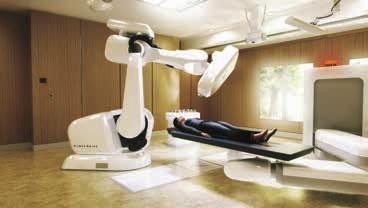






In a new four-part series for Independent Practitioner Today, Malcolm McCoskery (right) examines key issues facing consultants as they look to build their practice. Here he covers whether to work as part of a multi-disciplinary team or, indeed, if single-handed practice is still relevant in today’s market.

Each article is aimed at consultants who may be at different stages of their career. Their private practice may need to be built from scratch. Or it may be that they started their practice some time ago and wish to take their business a stage further either by themselves or possibly, like many other consultants are doing now, as part of a group.
If the consultant is already well-established, then working in a team may not seem attractive, but in modern, regulated practices, it may still be advantageous to be involved in a group
A mAjor decision consultants need to make at the outset of their career in private practice is whether go it alone or work as a team.
A choice may also have to be made later on as the consumer marketplace changes and regulations dictate. it may also be that at the outset of a consultant’s pri-
vate practice career, there was no option to grab the opportunity to work in a team.
Historically, pretty much every consultant starting their practice did so single-handedly. Life was simpler.
Local GPs who knew you from your n H s employment would automatically refer to your prac-
There are good reasons to remain single-handed

tice. Although work was monitored, there was nowhere near the same level of regulation that exists today.
Hospitals were able to market your practice without the worries of breaching the terms of the Bribery Act. A website was where spiders caught their food, and as for social media…
m any consultants, in fact the majority, will nevertheless initially opt for this solo approach. There are still many advantages of going alone.
The main one is that you maintain control of your own destiny. You organise your practice how you want, where you want, with whom you want and when you want. Your revenue generation is down to you.
For many consultants, especially those working in towns or small cities where private patient
choice is limited, there are good reasons to remain single-handed.
For those in large conurbations, and in particular the central London market, there are more and more consultants who have decided that teamwork offers significant advantages and an interesting and viable model to the more traditional single-handed approach.
i should, at this stage, define what i mean by a team in the context of this article. it is one that is simply based on a specialty or within a distinct area of that specialty and is, most importantly, multi-disciplinary.
it is not about two or three doctors from one discipline who have conveniently linked up. Also, i do not refer to teams of doctors who have been personally recruited to join a specific clinic, as they are generally cross-functional rather than multi-functional in their format and approach.

j ust think what the patient is looking for in our fast-moving 21st-century society. They want to see the right person for the initial consultation at a time convenient to them. They seek a fast and accurate diagnosis and, if necessary, treatment concluded quickly, successfully and safely. Their insurance company will also be wanting similar outcomes with the added requirement of some sort of cost containment.
The multi-disciplinary team ( md T) can offer the best outcomes for all concerned. i t can often mirror an nHs mdT and is a group that can either be put together by the private hospital or modelled by the consultants themselves to work at more than one hospital.
An ideal md T would include consultants from the same specialty but perhaps with differing special interests. it should also include diagnostic consultants such as radiologists, pathologists, and, if relevant, anaesthetists. if based at one or more private hospitals, the group should include a clinical nurse specialist at each who can act as a gobetween for the team, the hospital and, most importantly, the patient. d epending on the specialty, the md T could also include allied health professionals ➱ p24
An independent firm offering one to one meetings anywhere in the UK giving advice and help with:
• how to start in private practice
• how to maximise private practice income
• ways to reduce tax payments
• setting up in Chambers/Groups
• limited companies and LLP’s
• financial planning
• record keeping

• computer software
• tax and financial advice re: car purchases
• pensions: NHS, personal and employee schemes
• purchase of consulting rooms and surgeries
• inheritance tax and capital gains tax planning
• VAT
For more information please contact us by: Wilmslow
Phone: 01625 527351
Fax: 01625 539315
Harley Street
Phone: 020 7307 8759
Fax: 01625 539315
Email: info@sandisoneasson.co.uk
Website: www.sandisoneasson.co.uk
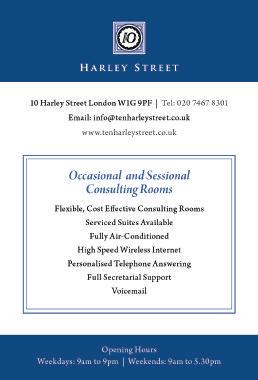



UK Top 20 accountants specialising in the healthcare sector
• National firm of the Year 2013 AISMA member (Maidstone and Leicester offices)
• 12 offices including London City
• Tax Structures for Hospital Consultants - dispelling myths
• Surgeon groups and consortia GP Practices including mergers and federations
• Solvent liquidations (for companies at the end of their lives)
For more information please contact:
South East
James Gransby FCA
E: james.gransby@mhllp.co.uk
T: +44 (0)1622 754033
M: +44 (0)7712321899
East Midlands


Robert Nelson DChA FCA
E: robert.nelson@mhllp.co.uk
T: +44 (0)1162 894289
M: +44 (0)7814009160
General email: healthcare@mhllp.co.uk www.macintyrehudson.co.uk


such as dieticians, pharmacists and physiotherapists.
Working together as an mdT, if the nominated consultant is away for any reason, it is likely that the team can offer satisfactory levels of cover. This is one of the most important advantages of teamwork compared to that of the single-handed practitioner. The team also has to operate with total trust in the abilities of its members, otherwise it will fail. so wherever the team members are recruited from, it is important that they fit together, not just in their capability – which from a professional status is almost certainly a ‘given’ – but emotionally too. every team in all walks of life has to function with like-minded people.
Financial consequences

Trust also covers the financial aspects of the group too. There may be different ways the team can set itself up in their financial arrangements. This article is not covering the advantages or disadvantages of what type of group to form. A limited-liability partnership? A formal or an informal group? These are questions for an accountant. But whatever route is taken, there will be financial consequences.

I would argue that the day of the single-handed practitioner in a modern, busy, city consultant practice is – just like for GPs –becoming more and more limited
The beauty of the team approach, however, is that consultant 1 can, of course, benefit if consultant 2, another member of the mdT, receives a referral best seen due to the special interests by the former. And vice-versa. it is this type of ‘one-stop shop’ that appeals to patients who are not sent from pillar to post and are seen most appropriately from day one.
As such, if the md T is determined and the right private hospital chosen and the brand and marketing are strong (see this series again in April, m ay and j une), then the team should be optimistic about receiving higher returns for everyone in the future.
The team will need administration and, depending on its size, a practice manager should be appointed.
Also, some teams have additionally attributed non-clinical responsibilities to each member –for example, marketing, finance, audit or human resource management. But it is usually better to bring in expertise from outside and let the doctors spend time in what they do best as well.
mdT members may have to recognise that financial rewards, at the outset in particular, may not meet current or – indeed if already established – past expectations because revenues need to be


The idea of consultants working together is, of course, not new, but crucially in the past, the ‘team’ has just included, say, a group of surgeons who have buddied up without the whole mdT approach.
A true mdT offers a more holis-
tic appeal for patients seeking that fast and accurate diagnosis and treatment.
The more patients that receive this level of care, the more that they, together with their GPs, the insurance companies and indeed the hospitals where the md T works, will appreciate and recognise this system offers significant advantages to all.
it has worked well in the nHs setting now for a while, but is only just being introduced more extensively in the private sector.
s o, bearing all this in mind, i would argue that the day of the single-handed practitioner in a modern, busy, city consultant practice is – just like for GPs –becoming more and more limited and does not offer the same level of service or the breadth of expertise provided by a good mdT.
in all walks of life where success depends on lots of people working together, good teamwork involving chosen expertise is bound to reap rewards for the future.
As such, a talented and professional mdT, i believe, offers posi-

Where success depends on lots of people working together, good teamwork involving chosen expertise is bound to reap rewards for the future
By pooling expertise, you gain from a team approach, selling to both private and public sectors
Patient receives best advice and treatment
Cover likely if consultant is away
More scope to be able to market yourselves
opportunities to publish combined data to promote the MDT
Teamwork can aid audit and regulatory enquiries
Long-term growth potential
tive solutions to many healthcare stakeholders in both the private and public sectors.
These include, first and foremost, patients, but also importantly insurance companies, international purchasers, the private hospitals, the mdT members themselves and, indeed, the nHs looking to spot-purchase expertise to meet their targets and deadlines.


You make the decisions
You take the rewards
Next month: the pros and cons of choosing a private hospital for your work
See ‘Perfect partners’, p32
Malcolm McCoskery, a marketing and business development manager, has had a 20-year private hospital career included senior management posts at four different private hospitals/groups. He can be contacted at m.mccoskery@yahoo.co.uk



• Cost effective and
• Fees charged on money
• Services tailored for each client







Lights, camera, action! Many more independent practitioners could be enjoying the business-building potential of YouTube, says surgeon Mr Dev Lall
Marketing your private practice is really nothing more or less than communication; about getting your message across to people who could go on to become patients.
and different people prefer to receive information in different ways. Some prefer to read; others prefer something more visual.
o ne of the most successful ways of getting your message across to people is through television.
i mean, think about it: for the majority of people in this country the primary mode of ‘recreation’ is to curl up in front of the telly.
We’ve become very much conditioned to receiving information in this way, and there is even a suggestion that people are not only more receptive to information presented in this way but that they are also less critical of it.
i n other words, they are more likely to accept what they see and hear as the truth. Being seen on t V naturally conveys authority. now, i’m not proposing that you splash out an eye-watering sum of money to launch a t V advertising campaign. But what i am suggesting is that you take a close look at the next best thing – launching your own t V channel on the internet via youtube.
who wants to be a TV star?
Some years back, g oogle bought you tube, because g oogle recognises the importance of traffic: visitors, in other words, to websites they own.
a nd if there’s one other thing you, too, must understand when it comes to marketing your practice, it is the importance of traffic – visitors.
i n other words, having as
large a number of people as possible who encounter information about you and what you do. So if 100 people visit your website/see your advert/ read your Pr piece in the local paper and X per cent of them go on to become patients, you now know that all you have to do to get more patients is to increase the numbers of people seeing that piece. your results are scalable, in other words. Which is why promoting yourself on you tube is such a fantastic opportunity.
People love to watch video, and it just so happens that youtube is the third most visited website on the entire internet.
Using YouTube to grow t here are two basic ways you can use youtube to grow your private practice.
the first is using it to adver-
tise. We’ve all seen this before, I’m sure: you go to YouTube to watch a music video or film clip and when you click ‘play’, an advert comes on first.
These adverts are produced by companies and presented to viewers according to criteria the company chooses by YouTube.
The interesting thing is that you don’t need to be a large company to do this. Anyone can advertise in this way, and it is astonishingly cheap. So cheap, in fact, that it is free, because adverts are presented using the pay-per-click model in the same way as Google AdWords.
All you have to do is to create a snippet of video – which can be as cheap or as expensive as you like to produce – upload it and, using your AdWords account, tell the automated system how, where and when your adverts are shown. Your adverts will be shown at no cost to you. You are only charged if someone watches them for longer than 30 seconds or clicks through to your website.
The cost of each ‘click’ depends upon many factors, but basically boils down to the competitiveness of the keyword that you want to ‘trigger’ your advert.
And in any case, the important thing to remember is that the cost per click is immaterial: what matters is your return on investment. If you’re making a decent return, then you shouldn’t be worried about the cost per click at all.
Pay-per-click is an awesome way of advertising your business. In video terms, it’s a bit like having your adverts come up on primetime TV for free – and you are only charged if someone goes on to become a patient. How amazing would that be?
The second way of using video on YouTube to grow your practice is by hosting your own information videos. You can quite easily set up your own YouTube channel – in effect your own TV station –where you can present videos that showcase and highlight your expertise.
Setting it up is pretty straightforward: it is free, will take you only a couple of hours and you don’t need to pay an expert to do it for you. You will need to set up a Google account first and then
You can quite easily set up your own YouTube channel where you can present videos that showcase and highlight your expertise
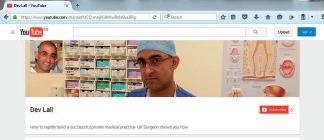
click on the menu to set up your own YouTube channel.
Think of a name you want to give the channel – obviously something relevant to your specialty would be a good idea, or perhaps the same name as your website, if that has been well chosen.
Once you have done that, you will need to upload some graphics to make it look appealing. You will need a banner graphic 2,560 x 1,440 pixels in size, which is pretty big. It needs to be so that it will display correctly no matter what device your channel is viewed on. Also, ideally, you should upload a smaller photo of yourself to put as an inset.
The screenshot pictured above shows what I mean – here you can see the large graphic at the top of the page as well as the photo insert. You can choose whatever images you like or convert text to an image format and upload that if you prefer.
Once you have set this up, I recommend you think about what content you want to put on the page, as this will help you decide how you want to structure it.
For example, if you were an orthopaedic surgeon, you might want three sections, one with videos about hip replacement surgery, one with videos about knee replacement surgery and another about knee trauma and arthroscopy. Don’t worry too much about this, as it can be changed later on.
Recording your videos OK, so you’ve got your YouTube channel sorted, now to the bit that everyone baulks at: getting those videos recorded.
I guess the first thing to do is tackle that elephant in the room: not many people like the idea of seeing themselves on film.
I understand that completely, because it is true that film can be unforgiving in showing up our imperfections. Not only that, the unfamiliarity of the whole process adds to the anxiety.
But the good news is two-fold: firstly, you do not have to go on film yourself if you do not want to – you could easily record a video of a PowerPoint presentation with a voiceover if you wish.
And, secondly, if you do decide to go in front of the camera, while you need to look smart and professional, you do not have to seek perfection. Good enough is good enough.
Recording your videos
Probably the best sorts of videos are those where you are being interviewed by someone. This looks natural and it will reduce your stress at going on camera enormously – after all, you are simply answering the routine questions you get asked by patients on the conditions you treat, just as you do almost every other day.
The approach I recommend is to break down each clinical topic into several sections – for example, cause, diagnosis, investigations, management and so on. Then, for each topic, think of the top ten questions you are asked and answer them in the video.
Also think of the top ten questions people should ask – but don’t – and answer them too.
If you can add video clips of surgery being carried out or past patients being interviewed, then
so much the better – but, obviously, don’t make them too gory or scary.
The idea is to record snippets of video, maybe two to five minutes long, looking at different aspects of the conditions you want to attract. By doing this, you could easily create 10-15 short videos on each topic.
In the case of the orthopaedic surgeon above, he or she could easily have their own video channel with 30-40 video clips on it just targeting the three conditions mentioned. This would speak volumes to visitors about his/her expertise and authority.
huge opportunity
The reason I encourage people to do this is not only because of its power, but also because so few consultants are actually doing this. There is a huge opportunity out there, but it won’t last forever. The problem in all your marketing efforts is cutting through the ‘noise’ to reach those people you want to reach. There are so many people clamouring for our attention that getting heard is not always easy.
But with YouTube videos and video advertising, very few people in the UK are doing this at all. That means you stand out. That means your message is so much more likely to get heard. And that, in turn, means more patients.
Mr Dev Lall (right) is an upper-GI surgeon and runs a specialist private practice consultancy www.
PrivatePracticeExpert.co.uk

Dear Reader,
Subscribing to Independent Practitioner Today is the only way you can be sure you will see every issue. Don’t risk missing out. Our personal subscription for doctors and managers is only £90 a year and £210 for organisations. But you can cut this to just £75 and £180 respectively if you pay by direct debit.
So take advantage of this offer now for our unique business journal dedicated to supporting you in your private practice. We’re confident your subscription will repay itself many times over! Editorial director


Instructions to your Bank or Building Society to pay Direct Debits
Name and full address of your bank/Building Society
Instructions to your Bank or Building Society to pay Direct Debits Name and full address of your bank/Building Society

of account holders
sort code
Banks and Building Societies may not accept direct debit instructions for some types of
Banks and Building Societies may not accept Direct Debit instructions for some types of account To: The Manager
post your application (no postage required – UK only) to: independent practitioner today Subscriptions department, FreepoSt, po Box 36, plymouth, pL1 1Br
and Building Societies may
phone: 01752 312140 Fax: 01752 313162 email: lisa@marketingcentre.co.uk or subscribe online at www.independent-practitioner-today.co.uk if you want to pay by card


You can cancel a Direct Debit at any time, by writing to your Bank or Building Society. Please also send a copy of your letter to us.
Within a few months, every specialist working in private practice should have been asked to check data about their work before it is published to the public. Matt James (right) appeals for doctors to engage with the process


A tr A nsform Ation A l ye A r lies ahead for private healthcare. We have already seen a tranche of changes in how the sector operates following the Competition and m arkets Authority’s (C m A) Private Healthcare investigation order 2014.
Consultants working in private practice are acutely aware of the new rules around accepting private hospital incentives, which have placed additional pressure on their practice.
n ow there are more changes they need to be aware of and engaged in.
As the ‘information organisation’ appointed by the CmA, we at the Private Healthcare information network (PHin) have a legal mandate to collect and publish quality and safety information at both hospital site and consultant level by April 2017.
Aggregated information on performance measures, including: the number of procedures;
Patient satisfaction;
Adverse events; will be publically available to help patients make decisions when choosing a consultant and facility for their treatment.
We know many consultants and hospitals are feeling the pressure brought about by these changes. But while the changes brought about by the CmA order are significant, they are also necessary.
Patientfocused information has taken the centre stage in healthcare in recent years. t he evolu➱ p30
tion of websites such as n H s Choices mean that patients are no longer simply receivers of care. t hey are informed customers with the right to choose the care and provider that’s right for them.
e qually, while Care Quality Commission (CQC) inspections have had some teething problems, using quality information to improve standards and accountability is a welcome step. Unfortunately, privately funded care has somewhat fallen behind the nHs in this regard. for private healthcare to show its quality and empower patients, there has to be accurate, robust and transparent information in the public domain.
it is simply wrong that people have access to less information about quality and safety on health services they pay for than they receive on the nHs this is a real opportunity for consultants and hospitals to demonstrate to patients the quality of their services.
to achieve this, PHin needs to develop new systems and processes for collecting sensitive data on more than one million episodes of care.
o ver the last year, we have made significant progress with the help of our hospital members, currently representing over 80% of the private healthcare market, who have already started submitting data to help us shape and refine this complicated process.
for the next year, our focus will switch to rollout with all hospital sites and consultants, ensuring data is collected and validated securely and safely, while making
the process as straightforward as possible.
Practically, this year, we will focus on two key priorities with consultants.
1firstly, we will continue our engagement with the profession through the f ederation of independent Practitioner organisations (fiPo). fiPo has convened a Clinical o utcomes Advisory Group ( fi P o C o AG), which includes representation from the f ederation of s pecialist s urgical Associations and other specialty organisations.
o ur work with fi P o fits into three broad areas:
information from clinical registries and audits
Clinical registries have an essential role in improving patient care and are a valuable source of information. We are mandated by the CmA to engage with clinical registries and include relevant information in what we publish.
However, we are mindful that registries need to have reached a sufficient size and maturity for their information to add real value to patient understanding. since we have access to data on all episodes of private care, we may be able to help registries to understand the extent to which hospitals and consultants are actively engaged and, in due course, to help measure ‘compliance’.
o ver the next six months, we will be engaging with the leading registries, with the help of fiPoCoAG, to understand what information they have that is

by the autumn, we will be contacting every consultant working in private practice to ask them to log into our secure online portal and check their data

sufficiently comprehensive and mature to republish in a way that is appropriate and accessible.
fiPoCoAG provides an essential consultant view to ensure that the information we republish adds value to public understanding and is a fair reflection of performance.
proMs and other standard performance measures the publication of patientreported outcome measures (Proms) and other performancespecific measures is also explicitly covered by the CmA order. While most will be familiar with the four Proms used in the n H s , we will be encouraging hospitals to use up to 11 measures at each hospital site. this is a significant change for private healthcare, but all of the instruments chosen are wellestablished in their fields.
specialty association members have already reviewed each of the 11 measures, but where questions or concerns remain, we can still work through them.
for adverse events, similarly, we are taking known and established
measures to keep things simple. t hese include clinical indictors and infection control surveillance measures as submitted to the CQC, and ‘never events’ as defined by nHs england, which are familiar to the majority of hospitals.
Episode-level admissions data e pisode level admissions data is crucial for providing a meaningful context for many of the performance measures, as well as providing some of the measures directly and enabling risk adjustment.
We recognise concerns within the private healthcare sector that publishing measures such as mortalities and infection rates in isolation is misleading. these concerns may well be justified, as there are a multitude of factors which contribute clinical outcomes, not least the complexity of each case. Collecting admissions data will allow us to develop a process to adjust casemix at a more nuanced level and on a wider range of procedures than ever before. taking a collaborative and involved approach to our profes
sional engagement is a must if we are to fulfil both the letter and the spirit of our mandate. fi P oCoAG is an active and constructive clinical voice, shaping our thinking and adding authority to this process.
2o ur other priority area in 2016 is get all the thousands of consultants in private practice directly involved, ensuring they have the opportunity to see and check the data.
While some specialties have seen consultant level outcomes publication through registries and audits over the last couple of years, it is fair to say that the CmA’s order requires us to go further and across a broader range of specialties.
the CmA’s order actually places no direct obligations onto consultants in terms of producing outcomes measures. the duty to ensure that consultantlevel performance measures are published falls on hospitals and PHin
But it would clearly be wrong to cut consultants out of a process of producing data that is about them and potentially material to their livelihood.
so PHin has, through consultation with our members and stakeholders, interpreted this role so that all consultants will be asked to check their data and approve it for publication before we publish it.
t his should be an exercise in communicating the quality and value of private practice, and we want to ensure that every consultant’s work is accurately reflected. for that, we need your engagement. We understand there are a huge number of calls on your time and that you would probably rather be seeing patients than checking data. As such, we are keen to make the process as intuitive and simple as possible for everybody.
since January this year, private hospitals, including independent hospitals and nHs private patient units, have been collecting and coding data on privatelyfunded episodes of care.
By s eptember, all providers should be submitting their data to PHin to be processed and made available for checking in time for publication in April 2017.
By the autumn, we will be con
tacting every consultant working in private practice to ask them to log into our secure online portal and check their data. Prior to the full roll out, we are running a s pring pilot study with around 200 consultants chosen from across our founding hospital members.
t his will provide an opportunity to rigorously test the data we receive from hospitals, and processes for ensuring data is corrected, in a timely and responsive way.
if you have been asked to participate by your hospital group, it will contact you individually. We are grateful for your input.
Although the next 15 months will bring many challenges, we believe this will deliver private healthcare to a much better place. Ultimately, this is about showcasing quality and providing patients with the service they deserve in terms of choice and accountability.
to do that, the information must be comparable to that used in the nHs. this will require a collective effort from PHin, hospitals and consultants as we implement change.
But as we enter a ‘business as usual’ state from 2017, i believe we will start to see real and tangible benefits.
i am excited for the year ahead and confident in what we will achieve. for those not involved in our pilot or through the specialist associations and fiPo, there are no imminent actions.
But there will be practical changes in dataflows and collection as hospitals endeavour to comply with their new legal requirements.
As we look forward to the autumn, i hope all consultants will take the opportunity to engage with us. After all, only the consultants that engage with us can ensure the data which is published on their practice is right.
At the start of 2016, the CMA approved PHIN’s Strategic Plan 2015-2020, setting out its objectives, governance and plans. This can be downloaded from www.PHIN.org.uk
Matt James is chief executive of the Private healthcare Information Network (PHIN)










HMRC tax investigations and disputes create difficult and stressful times.
As an award winning firm of tax experts, our highly experienced partners specialise in resolving problems relating to tax investigations and disputes with HMRC.
To find out, in confidence, how we can help call 0800 734 3333.
‘Here to help. Not to judge.’

There is a developing trend in the world of primary healthcare that ‘bigger is better’.
This is perceived to be the case for a number of different reasons, including perceptions concerning the safeguarding of the business from unwelcome predators, the sharing of staff across a wider patch and perhaps – regarded as the least important in the present marketplace – the ability to ‘brand’ the business.
A similar concept is now being seen within the world of private healthcare, although for completely different reasons, and we are witnessing increasing numbers of consultants grouping together in ‘partnerships’ to deal with the private aspects of their practices. While it might be easy to assume a synergy between these and Nhs
To be or not to be a member of a limited liability partnership? That is the question for many independent practitioners. Lynne Abbess (right) gives a legal perspective and some useful tips
primary care partnerships, the underlying reasons are usually entirely different.
Different marketplace
it is essential not to presume that bigger is necessarily better or that one size fits all within the consultants’ world, which is a radically different marketplace. rather than being in a positon of needing to fend off unwelcome competition from other parts of the private sector, many consultants are so established within their specialty that this is not a significant risk.
Because of their degree of specialism, there is likely to be far less opportunity to move staff around, let alone to provide cover for each other at a senior level.
And what is of least significance
to GPs may be of the greatest significance to consultants – namely the ability to adopt a ‘brand’. specialist accountants have suggested in Independent Practitioner Today that merely banding together under an umbrella name can increase their combined ‘value’ by as much as 15%.
On the basis of this latter point alone, it may be perceived there are very positive reasons for agreeing to group together.
But it is not always the consultants themselves who are promoting this concept. increasingly, it is the organisations for whom they provide the services who are behind it.
You might ask yourself, why an Nhs trust would trouble itself to assist its consultants into improving their value – but the reason
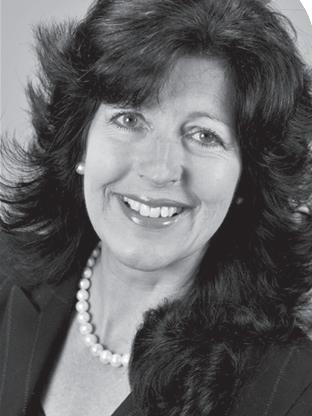
very often has nothing to do with the consultants’ position and everything to do with the trust’s.
The essential point behind this is that it is far easier for the trust – or other private healthcare organisation – to deal with one ‘corporate entity’ than to have to deal with a disparate band of consultants who are each ‘doing their own thing’.
h owever, before jumping on the bandwagon and agreeing to follow suit, it is crucial to appreciate the significance of doing so.
A history lesson
The usual ‘corporate entity’ which is adopted for these purposes is a limited liability partnership (LLP). This is a mid-way between a traditional partnership and a limited company.
The concept was originally promulgated by City firms of partners with global offices, who wanted to find a mechanism for limiting an individual partner’s liability for the negligence of an unknown partner on the far side of the world, while at the same time retaining what – certainly at that stage – was regarded as the benefit of the partnership tax structure. And so the Limited Liability Partnership Act 2000 was the result.
Unlike a traditional partnership, it is a corporate structure with its own ‘legal personality’ and, as such, two ‘designated members’ are required to file the application for formation – similar to the two directors/director and company secretary required to establish a new limited company.
new relationship
But this not simply a wrapper to which the consultant members may attach themselves in name alone.
it is the beginning of a new relationship for those who sign themselves up as members, where the values and principles of partnership are likely to be more immediately relevant than the pure corporate structure.
From the N hs trust’s perspective, it makes life considerably more straightforward, as it can simply enter into one service level agreement with the LLP and be done with it.
it is then up to the LLP to ensure it provides the level of service delivery required.
i nevitably, this necessitates each and every member of the LLP to play his/her part – and the entity may therefore be regarded as being as strong only as its weakest member.
Over and above this, however, there are a raft of other issues to consider, of which the following are just a few examples.
1
While the legalities attached to setting up the corporate entity are relatively straightforward, it should be noted that the two designated members are required to file their home addresses at Companies h ouse, making them available for inspection.
2 The LLP ‘wrapper’ having been set up, it is essential the members should enter into a formal agreement which sets out the basis of their relationship with each other.
Without this, one can only fall back on the default rules, which would be wholly inadequate to cater for the relationship of consultants working within a healthcare environment.
The amount of time required to cater for setting up a formal agreement should not be underestimated and you can pretty much guarantee it will be more complex than you had anticipated.
3 in addition to the members’ agreement, there will be the service level agreement to consider that will be entered into between the LLP and the trust/ private organisation.
This is all bound to necessitate legal advice and it should be appreciated costs will be incurred.
4 it will be necessary to have a joint partnership bank account into which all funds must be channelled.
The members will need to agree the basis upon which ‘drawings’ may be made from this account. This might, in practice, restrict the ability of members who are used to having rather more freedom as individuals to draw down at a time of their choosing.
5 inevitably, the LLP will not run itself. even after the initial steps have been taken to set it up, there will be ongoing decisions to take and it will be important to establish a method of taking this forward.
e ither the members should agree to delegate all responsibility to a management board on which only a few of the members sit –and be prepared to be bound by their decisions – or, alternatively, each member should expect to attend regular meetings.
6 Because the LLP has its own corporate entity, it is required each year to file its own tax return. By the same token, LLP accounts will be required. i nevitably, this will necessitate annual meetings with accountants – and costs will be incurred.
7
i t goes without saying that the members will have to agree the basis of distribution of profit shares. These are the ultimate earnings of each consultant member – as opposed to the drawings which he/she may be entitled to take on an interim basis.
To the extent each individual works in isolation to the others, this may be relatively simple to resolve on an ‘eat what you kill’ basis. h owever, to the extent there is any degree of overlap, or where ‘referrals’ are taken into account, a system for recognising this will have to be put in place –and honoured.
8 The LLP will need to employ staff to carry out the day-today duties associated with the running of the business.
s ome members may feel they derive less benefit from the tasks undertaken by these staff than others. it is likely to be very different from a regime where each consultant has a PA accountable solely to them personally.
Once again, this is not impossible to resolve, but it does mean a degree of tolerance will need to be adopted.
9 it is also important to appreciate that proper policies will need to be put in place relating to the employment of staff and the procedures to be adopted in the course of their employment.
i t is particularly important to recognise that if a grievance is raised, this would not be ‘contained’ between ‘the boss and his PA’ and would have to follow due process. if this were to result in a claim for unfair dismissal or, worse still, discrimination – for which there is no upper limit of damages – it would be a claim made against the LLP as a whole.
10 As individuals, consultants would not generally carry responsibility for each other’s actions or omissions. But there are exceptional circumstances in which members of an LLP can indeed be jointly and severally liable – and that is where there is evidence to support the fact they have effectively both been involved in the same ‘activity’. it may be thought that this is not very different from any current
arrangements, but there is a subtle distinction between the liability of members acting jointly through an LLP, compared with consultants working alongside each other under individual contracts.
11 Following on from this, it would certainly be essential for the LLP to ensure professional indemnity cover is taken out for the members as a group. And once again, the cost of this is likely to be determined upon the claims history of the group as a whole.
12
r ules governing the departure of a member will have to be agreed, including the thorny issue of whether this should attract the payment of goodwill – and whether any form of restrictive covenant should apply. similarly, rules will have to be agreed concerning the desire to admit a new member.
13
And there will be costs associated with all of this: legal costs to set up the LLP and members’ agreement, together with any subsequent changes –and annual accountancy fees.
This highlights just some of the issues to be considered in the course of setting up an LLP.
There is no reason why these should not be resolved successfully as long as each and every individual member approaches it with his/her eyes wide open and with a desire to make it work.
Those who are looking for issues to challenge will be bound to find them and there may be little point in prolonging the agony with those individuals – another issue to resolve if they happen to be the ‘key players’ required to make the LLP work successfully.
Above all, before embarking on this process, it might be wise to consider what you as an individual stand to gain overall before volunteering to put yourself on this particular track.
Assuming a degree of co-operation all-round, however, there may be no reason why you should not reach the end of your journey successfully.
Lynne Abbess is a partner and head of professional services at Hempsons Solicitors

As retirement beckons, Gary Nials (right) urges you to make sure it doesn’t leave you with an unexpected heavy workload – chasing thousands of pounds you suddenly find you are owed
Nearly all of us work for most of our lives but few think of what will happen when we reach retirement age.
as we normally work 30 to 40 years and then have an average of 20 years of retirement, we should be planning and saving for retirement as soon as possible.
Whether it is years away or just around the corner, the most important person to speak to when planning for retirement is, of course, a financial adviser.
They will tell you that you need at least half of your annual income to live comfortably in retirement. They will advise you on pension arrangements and give advice on your NHS pension.
But there is another financial aspect of retiring that can easily
be forgotten. Making sure you do not finish your working days with a huge backlog of unpaid bills owed to you by patients.
So, if you are anywhere near retiring – and even if you are not – I would advise you to check your billing is it up to date.
If retirement is beckoning just around the corner and you find your billing is not up to date, then it really needs to be sorted as soon as possible.
For many consultants I come across, their billing is very much behind. So when you are thinking of retiring, addressing the billing should be at the top of the list.
Three-quarters of the consultants who come to us to do their
billing have some sort of backlog of invoicing and 50% of those have billing older than three months.
The important thing to realise is that old debt is a lot more difficult and time-consuming to chase compared to your day-to-day billing.
If it is discovered that comprehensive notes have not been kept, then it is likely that the work has not been billed in the first place. you are then likely to find more questions from the payees because the debt is old and they may not remember the details of procedures or consultations.
So before starting, it is important that you gather together all the information you can to ensure the invoicing is accurate and you

have the answers to the questions that will inevitably arise.
Most consultants’ debt that we take on drops into three main buckets: insurance, embassy and self-pay.
Insurance should be the first one to check as most insurance companies pay their invoices between 20 to 60 days without any problems.
They also do not like receiving new invoices for treatment dates older than six months.
If you have any older invoices than that, there will be a problem. In order to rectify this, you are going to need to contact the insurance company’s provider helpline.
Make sure, you have details of the patient, especially their membership number. In the first instance, quoting your invoice number and provider reference should allow them to explain the problem.
Once you know what the issue is, sort it as soon as possible. a nother reason for making sure insurance billing is up to date are patient shortfalls, where the patient has an excess or contribution to make. These will then turn into self-pay invoices and require further chasing.
Chasing self-pay debt is never nice, as no one wants a phone call out of the blue saying they owe money. Self-pay invoices should have been ideally raised immediately after the consultation or procedures. and chased frequently. Old self-pay debt normally means you have been chasing for
Self-pay invoices should have been ideally raised immediately after the consultation or procedures. And chased frequently
agency expert in the recovery of long-overdue invoices.
The other choice is to write it off as bad debt. This will have a tax benefit, but it is important that you have good reason to consider it bad and know it is an irrecoverable debt, meaning there is no chance of receiving the payment. you must show that you have made every effort to try and get paid, otherwise it cannot be written off. a gain, your accountant should be invaluable in helping you make the right decisions.
quite some time but making little progress. This sort of debt should be reviewed with your accountant to make the decision on whether it is worth pursuing or not. Some of the debt could be handed over to a professional
embassy debt could be the most problematic for you because they will eventually pay, but this will take you some time and effort. you cannot write off embassy debt in most circumstances; you can only really chase. a good method is to print out all your outstanding invoices with the copies of medical reports and let-
“Kay and her team provide a seamless outsourced switchboard service. The result? More enquiries, outstanding service levels.”
Moneypenny client since 2013
Moneypenny will support your existing team by looking after overflow calls, or by providing a fully outsourced switchboard facility.
moneypenny.co.uk
0333 202 1005
ters of guarantee and take them to each embassy. This will usually yield results and will be time well spent.
In conclusion, retiring is a complex business requiring the help of experts. a financial adviser will help determine your retirement financial requirements. a n accountant can help with the financial aspects of your private practice.
But it might be worthwhile to use the services of a billing company to sort out your invoicing and collection of your outstanding debt. This would allow you to concentrate on those retirement plans.
you don’t want the hassle of having to still chase money owed at a time when you could be using it to go round the world or enjoy new, hard-worked-for pleasures.
Gary Nials is the managing director of Medical Billing and Collection
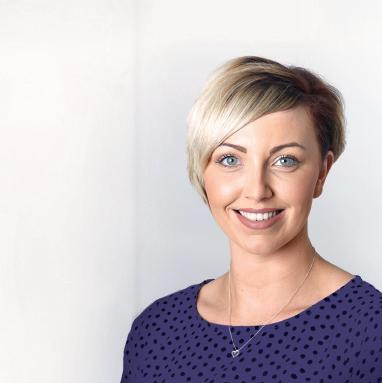
independent Practitioner Today has joined forces with leading niche healthcare lawyers hempsons to offer readers a free legal advice service.
We aim to help you navigate the ever more complex legal and regulatory issues involved in running and developing your private practice – and your lives.
hempsons’ specialist lawyers have a long track-record of advising doctors – and an unrivalled understanding of the healthcare system as a whole.
call hempsons on 020 7839 0278 between 9am and 5pm monday to Friday for your ten minutes’ of free legal advice.
Advice is available on:
Business structures – ian hempseed
Commercial contracts – Faisal dhalla
disputes – hilary King
hR/employment – Fiona mclellan
Premises – lynne Abbess

If you can keep your head while all about you are losing theirs…Simon Bruce (right) reminds us not to panic when looking at market performance

It I s never a nice feeling when markets go through periods when they fall.
And it certainly does not help to settle the nerves when we see sensationalist headlines like ‘RB s cries “sell everything” as deflationary crisis nears’ ( Daily Telegraph ) or ‘Worst start to market year in two decades’ (FT.com).
to feel unsettled is natural; to panic and sell out of equities is an unreasonable overreaction to the normal workings of the market.
Remember that there are many analysts and economists who do not hold these views, but headlines such as ‘Markets might go down or up, or sideways, who knows?’ are hardly going to make the front pages.
For those who have been
around markets for many years, the recent slump is just another step – this time backwards – on the bumpy journey. two steps forward, one step back would not be an unreasonable mantra for stock markets. Large-scale market falls and their recovery is the nature of equity investments.

WorST JanuarieS Since 1975 in gloBal developed markeTS
period Fall in January return for year
January ‘09 -9.5% +30%
January ‘90 -9.0% -10%
Janaury ‘08 -7.6% -30%
January ‘00
Source: MSCI World Index (dividends reinvested) in GBP, before inflation


take a look at figure 1 below, left. It shows the quarterly performance of the MsCI World Index –a stock market benchmark of global stocks – since its inception in 1975. One could hardly say that the returns at the start of the year have been out of the ordinary. table 1 above shows the worst months of January in world markets since 1975. this reveals that the start to the year has little bearing on the outcome for the year. there is no reason why it should.
nonsensical advice to follow RBs’s advice to ‘sell out of everything’ is nonsensical and, for long-term investors, entirely inappropriate. No one knows what is going to happen in the markets. All we know is that, over longer-time horizons, equities are more likely to deliver higher returns than bonds and cash. Remember, too, that any decision to get out of equities also requires another decision to get back in.
When would you pull the trigger and get back in? If markets crash, the chances are that you will be too paralysed with fear to get back in and, before you know it, the market will be up and you will have missed it.
Markets tend to move with magnitude and rapidity. there is no one ringing a bell telling you when to get in or out. If you have a robust, diversified portfolio designed to withstand tough challenges, simply be brave and stay invested.
A recent piece of empirical research, which looked at professional money managers who manage multi-asset portfolios owning bonds and equities revealed the alarming truth that very few (less than 2%) of UK fund managers showed any ability to time when to be in or out of markets successfully. Perhaps not surprising if you believe that markets work.

Jack Bogle – the financial legend who founded investment company Vanguard – states: ‘sure, it
What happens if you sell equities now and the markets rise from here? If the markets rise, you will have lost out. ➱ p38

There are some important things to remember at times like these:
markets work pretty well. They absorb all of the information publicly available to investors in their prices. The news on china is not new and should already be fully reflected in market prices
as such, markets go up, down and sideways from time to time, depending upon the release of new information
When investing, you do not make a financial loss unless you sell your holdings. if you are a long-term investor, you have the luxury of being able to hold your assets until the storm passes
now is the time to check the stability of your portfolio. if it is welldiversified with a carefully considered balance between bonds and equities, then the performance of your high-quality bonds will mitigate the effect of equity market falls on your portfolio. if so, those headline numbers are not your numbers, as you are not 100% invested in the equity markets
it is not all doom and gloom: the uS and uk economies are still growing strongly. The uk has more people in the workforce than ever before. new car registrations have just reached an all-time high. petrol is 99p a litre. uk gross domestic product per head is above pre-crash levels
would be great to get out of the market at the high and back in at the low. But in 55 years in the business, I not only have never met anybody that knew how to do it, I’ve never met anybody who met anybody that knew how to do it.’
As we always say, remember that investing is a long-term game that requires patience, discipline, fortitude and time. At Cavendish, where portfolios are built to weather any storm, our clients
know to block out the market noise, stick with the programme and not look at the transient value of their portfolio too often. As a wise old sage once said: ‘Look at your cash everyday if you like, your bonds every three years and your equities every ten years.’
Simon Bruce is managing director of Cavendish Medical, specialist financial planners helping senior consultants in private practice and the NHS
This content of this article is for information only and must not be considered as financial advice. Cavendish Medical always recommends that you seek independent financial advice before making any financial decisions.
Levels, bases of and reliefs from taxation may be subject to change and their value depends on the individual circumstances of the investor. The value of investments and the income from them can fluctuate and investors may get back less than the amount invested.

How
up to date is your will? edward Jacobs outlines some vital considerations for independent practitioners
FOR the busy independent practitioner who is juggling a heavily congested schedule, making a will can often be overlooked and forgotten about.
t his is understandable given the significant professional and personal demands on a practitioner’s time. h owever, wills remain an essential piece of planning which require careful thought and consideration.
You should understand the implications of what happens when a person omits someone, either intentionally or inadvertently, who might otherwise have had a legitimate expectation of inheriting under that person’s will.
As you will see, sometimes what a will does not say can be almost as significant as what it actually does say.
Recent developments: ilott vs mitson
some doctors may recall that in August 2015 there was a case where heather Ilott was awarded £164,000 from her mother’s estate by the Court of Appeal after being excluded from her mother’s will. Relations between her and her mother Melita Jackson were strained for many years. the pair had been estranged since Mrs Ilott left home at 17 to marry a man, whom she remains married to
and has had five children with. Various attempts at reconciliation were attempted but proved unsuccessful.
As a result, Mrs Jackson made a will leaving her entire estate to three animal charities. such was her determination to exclude her daughter that she instructed her executors to resist any claim her daughter might bring against her estate.
It is important to remember that while a person has the ability to leave property to whomever they wish – known as testamentary Freedom – that under the Inheritance (Provision for Family and Dependents) Act 1975, a limited category of people can bring a claim if a will fails to make reasonable financial provision for them.
Mrs Ilott qualified as an eligible claimant. she then had to prove that her mother failed to make reasonable financial provision for her maintenance by leaving her nothing in her will.
there have been various hearings with judges reaching contrasting decisions. At the first hearing, the judge awarded her £50,000. At the high Court, the judge refused to increase this award.
t he decision by the Court of Appeal was that Mrs Ilott should receive £164,000. this was largely for the purposes of buying her housing association home.
When arriving at this decision, the court considered two separate factors. Firstly, that Mrs Jackson had left her estate to charities to which she had little connection, and, secondly, that Mrs Ilott was in receipt of benefits.
A court will therefore assess the personal circumstances of those involved, their financial needs and resources, both now and in the future, as well as other matters such as disability/health and the conduct of those involved.

Despite some media reports, it is wrong to say that all wills are now ineffective and worthless.
Instead, the key point is that if you wish to make no provision for a family member or loved one in your will, then clear reasoning should be given for doing so.
While this does not necessarily preclude a claim, it would provide a court with important guidance as to what the will-maker’s rationale was at the time.
Failure to make a will
It is also possible to inadvertently omit a person from inheriting your assets if you do not leave a will.
For example, someone may be in a long-term relationship with a partner but they are unmarried. In such a scenario, the rules of intestacy will apply.
these are a set of rules dealing with what happens when there is no will and will normally favour blood relatives. No consideration will be given to a ‘common law spouse’ – an often-used but sometimes misleading term.
Instead, the omitted party will have little choice but to resort to making a claim under the Inheritance (Provision for Family and Dependents) Act 1975, which was relied upon by Mrs Illot. If the matter is hotly contested by family members, this can lead to an expensive and time-consuming legal process being endured.
t he above scenarios demonstrate the need for a person to have a will in place. Not having one can cause great uncertainty, expense and distress for those left behind – at any already very difficult time.
however, it is also essential that the will considers all personal circumstances and therefore specialist advice in drafting a will is highly desirable – as indeed it is with all situations where a will is required.
Edward Jacobs (right) is a solicitor with the wills trusts probate department, Gross and Co, Suffolk

Have you ever wanted a home in the French Alps? Ski all winter and enjoy long warm summer days? Fantastic food and wines? A wonderful place to share with your friends and family? Something that will really add to the quality of your life and be a good investment? Dylan Mitchell looks at this year’s best buys


In the last year, demand from foreign buyers for chalets and apartments in the French Alps has surged.
the exchange rate between the British Pound and the e uro means that this is one of the best opportunities to buy property in France for a decade.
Buyers are already seeing capital growth and receiving higher rental incomes than are available in most of the UK. Combined with low mortgage rates, this makes an ideal opportunity to secure that dream home.
If you are thinking of using a mortgage, first speak with a mortgage adviser to confirm how much you can borrow and how much the repayments will be each month.

even if you are in the fortunate position to be able to buy a property for cash, with interest rates as low as they are, you may find it a better use of your capital to use a mortgage, not to mention more tax-efficient.
Once you have confirmed your budget, the fun starts. By dealing with an agent who covers the whole of the French Alps, you will be able to compare different styles of properties as well as prices from across the Alps. Once you’ve narrowed down your choice, then arrange a long weekend to go and view the properties and explore the area. the estate agent and mortgage adviser will be able to guide you through the paperwork involved. You will be asked to pay an initial deposit to secure your reservation and take the property off the market.
You should always pay this deposit to the notaire (lawyer) not the agent or owner. Unlike solicitors in the UK, who represent either the buyer or seller, French notaires are independent and work on behalf of France.
If you are buying a new property from a developer, you will be asked to sign a reservation agreement. Or if you buy an existing property, you will complete a compromis de vente. In both cases, you must include full details of the mortgage product that you are applying for.
In addition to the cost of the property, you will need to allow for legal fees and taxes. If you are buying an off-plan property, the price will already include VAT, so the legal fees will be approximately 2.5%. If, on the other hand, you buy an existing property, the stamp duty and legal fees combined will be about 7.5%.
One of the key advantages of French mortgages compared to UK mortgages is that the interest rate is for the term of the mortgage, not just for a few years as in the UK. This means that you can lock in the current low rates for up to 25 years. Products vary from bank to bank, but at the moment UK residents can borrow up to 85%, with a choice of variable, capped and fixed rates from 2% to 3.3%.
A very common method of buying apartments in the French Alps is through the leaseback structure.
This was created by the French government in the 1960s to encourage investment into tourism accommodation, which is important when you are the number-one tourism destination in the world.
Under the leaseback structure, you purchase a freehold apartment, which you then lease to a management company, in exchange for a guaranteed rental income (inflation-linked). If buying a new apartment from a developer, then the 20% VAT is refunded as a very attractive tax break.
In the UK, French Leasebacks are classified as Long Term Furnished Holiday Lets, which means that they are exempt from the recent tax changes affecting UK buy-tolet investors. This makes them especially attractive to higher-rate tax payers.
French Leasebacks offer a hasslefree way of owning a second home, with a management company that markets your property, deals with the day-to-day maintenance, pays all the running bills, and then pays you a guaranteed level of income which increases with inflation.
In addition to the financial benefits are the facilities to which owners have access. French Leasebacks are more like hotels than apartment blocks, so residents expect them to have luxury spas with jacuzzis and saunas, restaurants, bars, heated swimming pools (inside and outside), ski lockers, children’s clubs, gyms,

french leasebacks are more like hotels than apartment blocks
wifi and, of course, to be in good locations within a resort, close to the shops and restaurants and ideally ski in and ski out. As an owner, you have access to all these facilities.
The only real downside with French Leasebacks is that you cannot access your property whenever you like.
Obviously, the management company is looking to book your apartment as much as possible, so you need to reserve the weeks that you want to use your apartment well in advance.
Here are just a few of the latest DevelopMents to choose froM…

Coeur des Loges – Les Menuires (French Leaseback)
€149,000–€778,000
Awarded Best Family Resort at the 2015 World Snow Awards, this is an ideal location for family holidays. Coeur des Loges is a fourstar resort, part of the Three Valleys ski area, with pistes to suit all levels.
Coeur des Loges boasts a selection of one- to four-bedroom apartments and excellent facilities such as heated pools, luxury spa and sauna and restaurants.
the management company is looking to book your apartment as much as possible, so you need to reserve the weeks that you want to use your apartment well in advance

Mendi Alde – La Clusaz (French Leaseback)
€143,000–€285,000
This picture-perfect traditional Savoyard village, combined with excellent skiing for all levels and only an hour from Geneva, makes La Clusaz one of the most popular destinations in the Alps.
This ski-in, ski-out four-star resort has studio to two-bedroom apartments and includes excellent facilities including a heated pool, Serge Blanco Luxury Spa, gym and private ski lockers.

Front de neige II – La Plagne (French Leaseback)
€105,000–€279,000
Dylan Mitchell is director of FrenchRealtyCo. com

• tax consultancy
• selfemployed and company accounts
• property investment structuring
• payroll and vat services
Contact: nick Brecker. tel: 020 7253 0030
Email: nbrecker@caldwellandbraham.co.uk
Web: www.caldwellandbraham.co.uk

Combined with Les Arcs, La Plagne forms the Paradiski ski area, with over 425km of slopes. This fourstar resort is literally on the slopes, offering easy ski access, and includes studio and one-bedroom apartments. Facilities include heated pool, luxury spa and sauna, restaurant and private ski lockers.

L’Hevana – Meribel Village (French Leaseback)
€380,000–€1.7m Meribel sits in the centre of the Three Valleys, the largest ski area in the world with over 650km of slopes ranging from 1,300m to 3,230m. Due to strict planning and a shortage of land, it is rare to get a new leaseback development in the
Three Valleys. L’Hevana is a fivestar resort and offers one- to threebedroom apartments with direct access to the ski lifts and all the luxuries you expect. Flats include open fireplaces and private saunas.

Le diamant des neiges –La Plagne. €291,000–€668,000 Ideally positioned near the shops and restaurants, with easy access to the lifts and the 425km of pistes of the Paradiski ski area, this development offers 12 apartments ranging from two to five bedrooms.

Le Clos du Savoy – Saint gervais les bains
€99,000-€583,000 Saint Gervais lies in the centre of the Evasion Mont-Blanc ski area offering 450km of slopes towards Megève, Combloux, Les Contamines Hauteluce and La Gietaz. This development is positioned right in front of the ski lifts and offers 40 apartments ranging from studios to three bedrooms.

Chalet Four Seasons, Châtel Châtel has become more popular since the two new lifts opened linking the ski areas of Super-Châtel and Linga, giving easy access to the 650km of pistes in the Portes du Soleil. This new development is positioned halfway between the centre of Châtel and the ski lifts and offers 38 apartments.
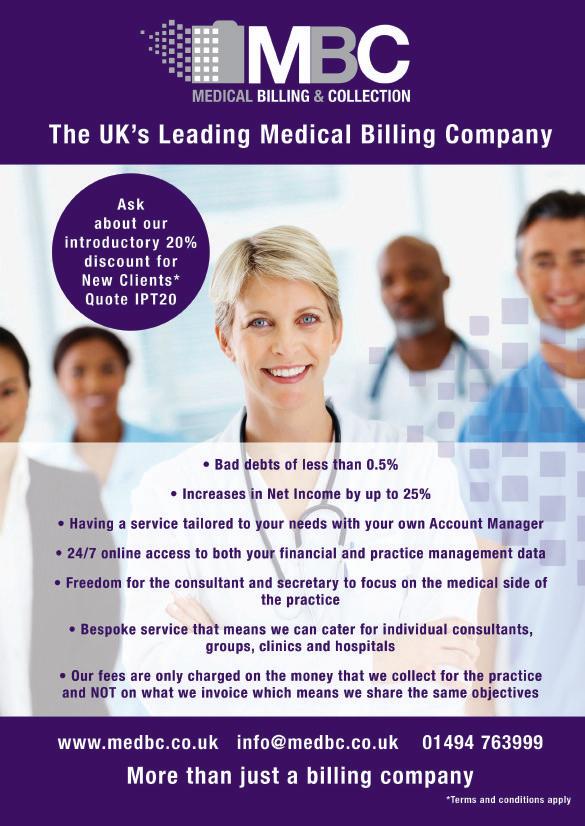

Doctors working as expert witnesses will be expected to substantiate their opinion with evidence. What constitutes ‘evidence’ – and can it be ranked in order of reliability?
The OxfOrd english dictionary defines evidence as ‘information indicating whether something is true or valid’.
When you are searching for evidence, you have to search for the right level of evidence. for example, a British practitioner would not be expected to know about the very latest research into the reliability of a product reported in a specialist journal published and only available in Japan.
h owever, it would not be unreasonable to expect the same practitioner to know about this topic if the same research had been published the previous year in a journal in the UK that is intended for doctors in the UK to read.

dence-based. This means that there has been a shift towards clinical decisions being based much more on research studies, and on studies that are quantitative rather than theoretical or qualitative. e vidence-based evidence carries weight.
Anything in a peerreviewed paper is generally considered to be good, strong and credible evidence.
You’ll be able to research and uncover your evidence at the BMA Library (see http://bma.org.uk/aboutthe-bma/bma-library/e-resources/ e-journals) or the British dental Association Library (see www.bda. org/library). Both offer online search facilities.
sPecIal offeR! buY the book and save £20
the book costs £60, but Independent Practitioner today has secured discount of a third off for readers, so you pay only £40. listen to the audio content which accompanies the book at this website: www.otmoorpublishing.com/audio. for more information and to order, email stephen.bonner@ otmoorpublishing.com, quoting reference ‘Young/IPt’.

If You found the evIdence In a book, RecoRd:
the author’s or editor’s name or names
the year the book was published
the title of the book
If it is an edition other than the first
the city the book was published in
the name of the publisher
foR jouRnal aRtIcles, RecoRd:
the name or names of the author/s
d octors have to keep their knowledge up to date, but it takes time for new research to filter through to the profession.
You must compare like for like and not expect every doctor or dentist to be familiar with the very latest research as soon as it appears in print. Professors and consultants in particular, when acting as experts, should bear this in mind when compiling evidence.
Your evidence has to be contemporaneous with the treatment or care under scrutiny. If you are asked to comment on care of treatment delivered or carried out in 2009, it is pointless quoting research from 2010.
Over the last few years, medicine has become much more evi-
The National Institute for h ealth and Care e xcellence is a good place to find the latest guidance on all things medical – see its website, www.nice.org.uk.
Any evidence you use in a report has to be referenced so that others, such as lawyers and other experts, can review the material to determine if it actually contains the information you say it does, and whether you’ve drawn the right conclusions from it.
Next month: The screening report
Adapted from The Effective and Efficient Clinical Negligence Expert Witness , by Michael r . Young, price £60 from Otmoor Publishing See ‘Business Dilemmas’, p46
the year in which the journal was published
the title of the article
the title of the journal
the page number/s of the article in the journal
as much other information as you can find about the journal; for example, the volume and issue numbers
foR electRonIc ResouRces, tRY to collect the InfoRMatIon as Is avaIlable, but also RecoRd:
the date you accessed the source
the electronic address or email
the type of electronic resource (email, discussion forum, uRl)
this is an example of good referencing:
Walls a.W.G, steel j.G. and Wassell R.j crowns and other extra-coronal restorations: Porcelain laminate veneers. british dental journal 2002; 193: 73-82
anything you reference should be included in the appendix of your report. to make it easy for the lawyers, I always also included photocopies of any papers, articles or pages in books that I had cited



This month Dr Kathryn Leask supplements our series on ‘The Effective and Efficient Clinical Negligence Expert Witness’ (page 44) by answering some key questions from doctors doing this work or planning to take it on
QI am thinking about supplementing my private practice income with expert witness work.
However, one of my colleagues has told me that an expert witness he knew was sued by the instructing solicitors after they had lost the case. Is it true that I might be at risk of legal action?
AThe public policy granting immunity to expert witnesses for negligence claims aris ing from an alleged breach of their legal duty was overturned in
or conduct at an expert’s meeting.
You should also bear in mind that the courts are now taking a more rigorous approach to ensuring that their timetables are met.
The Court of Appeal has emphasised that legal representatives should routinely comply with rules, practice directions and orders, rather than treating compliance as optional. While there is still some room to co-operate and modify the timetable, judges will now be stricter when parties fail to comply.
For example, the court may exclude any party from calling expert evidence if they have not
• Completely open scanner that is well tolerated by claustrophobic patients
• Weight-bearing scans for spine and joints enable a more precise diagnosis
• Patients who are large or cannot lie down can be accommodated
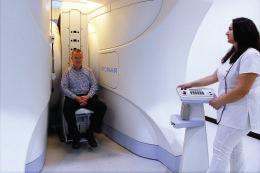

happens, there will be a risk that an expert may be personally liable for all costs.
With all this in mind, we recommend that you contact your medical defence organisation about your plans and ensure you are appropriately indemnified.
In addition to your indemnity, you might also want to consider joining a professional body and completing specific training in expert witness work.
Many doctors who intend to become expert witnesses attend specialist courses which cover report writing, the legal process generally and court appearances in particular.
QI have been instructed in the case of a middle-aged man who was suing following a back injury sustained in a car accident.
Since examining the claimant and writing my medical report, I have received additional medical notes which show that the claimant, a keen athlete, had been treated for spondylolysis some years ago.
I had not been informed of this when I wrote my report and it has led me to change my opinion about the impact of the accident on his health.
What should I do?
AIt is not uncommon for more evidence to become available as cases progress and if this information has led you to revise your opinion, you should advise the instructing solicitor as soon as possible.
Although you were instructed by the claimant’s solicitors, your overriding duty as an expert is to assist the civil court. Part 35 of the Civil Procedure Rules set out the expected conduct of experts and stipulate that you must be independent and write your report for the benefit of the court, not for the party requesting it.
A supplementary direction says: ‘If, after producing a report, an expert’s view changes on any material matter, such change of
Although you were instructed by the claimant’s solicitors, your overriding duty as an expert is to assist the civil court
AActing as an expert in a case which involves a former colleague could represent a potential conflict of interest, which will make it difficult for you to fulfil your duty to act independently and could lead to doubts about your credibility as a witness.
view should be communicated to all the parties without delay, and when appropriate to the court.’2
Your revised opinion is unlikely to be welcomed by the claimant, but this should not deter you and you should not feel any obligation to help the claimant make their case.
The courts take a dim view of experts who fail to observe the spirit of the rules by appearing to advocate a position rather than provide an opinion.
If you do nothing and the defence later questions you about the patient’s history, it could leave you vulnerable to criticism and even a GMC investigation.
The GMC expects expert witnesses who change their views to make sure the instructing solicitor, the other party and the judge are made aware of this without delay.3
It suggests the instructing solicitor will usually inform the appropriate people, but if this doesn’t happen, you should tell the court about your change of view or seek legal advice.
Finally, bear in mind that you have previously signed a statement of truth at the end of your report and could be found in contempt of court if you knowingly make a false statement.4
QI have been asked to give an expert opinion in a clinical negligence case. But I understand the claimant was treated at the NHS hospital where I used to practise until a few years ago and I am likely to have come into contact with the clinicians involved. Should I decline the instruction?
In this instance, it may be better to decline the instruction in line with the GMC’s ethical guidance which says doctors should avoid conflicts of interest wherever possible.5
If you had already accepted the instruction, you would have had an ethical duty to ensure those instructing you, the other party and the judge were made aware of this without delay.
In these circumstances, you could only continue to act as an expert witness if the court decides this possible conflict of interest will not affect the case.
References
1. Jones v Kaney [2011] UKSC
2. Para 2.5, Practice Direction 35 – Experts and assessors; Ministry of Justice website, accessed 17 December 2015. www.justice.gov.uk/courts/procedure-rules/civil/ rules/part35/pd_part35.
3. Para 15, Acting as a witness in legal proceedings, GMC, 2013. www.gmc-uk. org/guidance/ethical_guidance/21193. asp.
4. Para 32.14, Civil Procedure Rules, Ministry of Justice website, accessed 17 December 2015. www.justice.gov.uk/ courts/procedure-rules/civil/rules/ part32#32.14
5. Para 12, Financial and commer cial arrangements and conflicts of interest, GMC, 2013. www.gmc-uk.org/guidance/ ethical_guidance/21161.asp.
Dr Kathryn Leask (right) is a medicolegal adviser with the Medical Defence Union


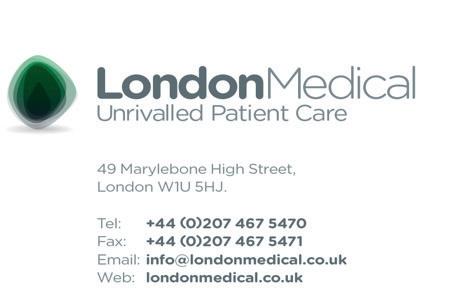



You don’t need to spend a lot of hard-earned income to get everything you need in a family car. Our tester Dr Tony Rimmer (right) finds the gap between mainstream and premium brand cars has never been so narrow

you would only need the automatic model if you live and practice in a city.
Do you remember clinical practice before routine CT and MRI scans became mainstays of our investigative armamentarium?

Like other modern investigations, we take them for granted and if we just stop to think, we wonder how we managed without them.
Advances in design and technology influence every aspect of our lives and the types of cars we buy are no different.
Not long ago, the only choice of family car we had was between a saloon, hatchback or an estate. Now we have sports utility vehicles (S u Vs), 4x4s and, most recently, crossovers. So what is this latest new class of car?
A crossover is something between a hatchback and an estate with some S u V pretentions. Clear? Well, S u Vs are designed with some off road ability and crossovers are not.
But some crossovers are available with fourwheel drive and some SuVs are available with twowheel drive only. If, like me, you find this rather confusing, then the carbuying public has obviously ignored the perplexity, as the crossover market has blossomed over the last couple of years.
The uK’s bestselling crossover is the Nissan Qashqai, but other contenders include the Honda HR V, Maxda CX 5, the Kia Sportage and the Hyundai Tuscon.
The most recent addition to the fold is the new Renault Kadjar and it arrives with impeccable credentials. Capitalising on the 16 years of Renault Nissan alliance, the Kadjar is built on the underpinnings of the classleading Nissan Qashqai but has its own body, trim and character.
A broad engine range includes the 50.4mpg 128bhp petrol 1.2TCe, the 73.4mpg 108bhp diesel 1.5dCi and the 62.8mpg 128bhp diesel 1.6dCi. An auto


matic gearbox is a £1,200 option on the diesel 1.5dCi only and a £1,500 4x4 option is available only on the top 1.6dCi model.
Various trim packages are available and my test car was the £24,795 1.6dCi Signature Nav model which is top of the range. It comes with full LED headlights, panoramic sun roof, cloth/ leather upholstery and a B o SE sound system as standard. Satnav, keyless entry and allround parking sensors with rear camera complete the package.
Neat feature one neat feature, and new to me, is automatic headlight dipping. The very bright LED headlights detect an approaching car and dip when necessary.
This works better than I anticipated and is a good aid to safety. These standard accessories help raise the feel of this mainstream Renault towards the level of the more expensive premium brands like Mercedes and BMW and I can
guarantee that these extras would hike their price significantly.
Crossovers are all about great packaging, ease of use and family friendliness. They seem to be the ideal solution for everyday use and the Kadjar is no exception. you sit higher than you do in a hatchback and this gives a greater feeling of security. The dashboard is modern and well laid out and there is plenty of room for four adults or two adults with three teenagers in the back.
Although the plastics feel a little cheap, the Kadjar is massively advanced from a quality point of view when compared with Renaults of old.
My wife’s first car was a Renault 5 and although it was a great car, I remember bits of trim falling off as you went along and, on one occasion, a window winder came away in my hand on a house call.
The controls are all light and easy to use and the steering is direct and pleasantly weighted. The gear change is so easy that
Handling is capable and predictable and only a keen driver would miss the sharper responses of a Golf or Ford Focus. The diesel engine’s noise is subdued and performance perfectly adequate.
There is a little wind noise at speed, but the overall refinement is impressive. o n the biggerrimmed 19inch alloy wheels, the ride is a bit firm but never uncomfortable. I would recommend the 17 or 18inch options for comfort.
So how does it rate against its classleading cousin, the Qashqai? Well, as one would expect, the driving experience is almost identical, but the Kadjar has more space and is slightly cheaper when comparing like with like.
Renault is trying to improve quality and move upmarket and this new car clearly demonstrates this.
If you are new to private practice or have significant early investment in your business, the new Renault Kadjar clearly shows that you don’t need to spend a lot of hardearned income to get everything you need in a family car. It may not have a Land Rover, BMW or Audi badge but it delivers at least 90% in all comparative areas.
The gap between mainstream and premium brand cars has never been so narrow. Despite its awkward name, the Kadjar deserves your consideration if you are in the market for great value family transportation.
Dr Tony Rimmer is a former NHS GP practising in Guildford, Surrey
ReNaulT KaDjaR dci 130 signature Nav
Body: Five-door hatchback engine: 1.6 litre four-cylinder turbo-diesel Power: 128bhp
Torque: 350Nm
Top speed: 115mph
acceleration: 0-60mph in 10.8 seconds
claimed economy: up to 62.8mpg
On-the-road price: £24,795
The big question: Should I lease or buy my medical equipment? Ian Tongue (right) has some advice
Consultants in many diverse specialties may need to invest in medical equipment and some of these can be extremely expensive.
t here is an old adage that if something depreciates, you should lease it – but is this the best option? Here i will look at different forms of financing and how the tax system can influence your decision.
What is leasing?
leasing is a form of rental for an asset. a finance company will put together a financial package that will be tailored to the value of the asset you are buying.
Because of the bespoke nature of medical equipment and the pace of technological change, most leasing arrangements do not expect the equipment to be returned. this is in contrast to, say, leasing a car, where there is a buoyant market for the leasing company to sell on the car after the lease term.
Buying outright or through hire purchase
this would refer to either a cash purchase or perhaps funding through a loan or other type of hire purchase (HP) agreement.
Buying outright from cash reserves is the easiest way, but it is wrong to think that there is no finance costs in using the funds. the investment return that you forgo needs to be taken into account. With interest rates still at their historical record low, this may be the cheapest form of funding, but should interest rates rise over the life that you have leased the asset, it could prove more expensive than first thought.
a loan or hire purchase agreement will usually require you to take legal ownership of the asset at the end of the term and you will pay interest on the size of the loan taken out.
Tax treatment n ormally if you buy an asset, either outright or through a loan/hire purchase, you receive a tax form of depreciation called Capital allowances. in contrast, when you lease an asset, you can deduct the lease rentals against your income as an expense. However, tax is never that straightforward and in certain situations the legal ownership of the asset is set aside and the substance of the transaction is taken into account.
this means that if you lease an asset for the majority of its life –usually more than five years –then you treat it as yours for tax purposes even though you may never own it.

Buying outright, hire purchase and certain types of lease will attract capital allowances and, at present, there is a special allow ance available referred to as the ‘annual investment allowance’. at the time of writing, this is £200,000 a year and allows you to deduct the cost of the equipment in the year of acquisition against taxable profit. this can provide a significant cash flow advantage.


Welcome to the BVRLA – I’m delighted that you’ve decided to join the trade association that provides a face for the vehicle rental and leasing industry, communicating its messages to customers, the media and government. The BVRLA’s corporate identity, particularly its logo, forms part of that message.
The BVRLA has three categories of membership, each with a logo that members are entitled to use (and, in some situations, are obliged to use). Appropriate use of our logo tells your customers, your suppliers, and the rest of the world that you adhere to the high standards that come with BVRLA membership.
This brief guide explains how we expect our logos to be displayed – and how they should not be displayed. These are not hard-and-fast rules, and we sometimes depart from them ourselves, but we do expect our members to respect them and to gain our prior approval before using our logo in any way other than described here.
o n the face of it then, both buying outright, hire purchase and certain types of finance lease should attract the same tax relief. But there are pros and cons for each.
If you need a copy of our logo, for use on your printed marketing material, or to go on a page of your website, please contact our communications team, who will be happy to send you an EPS or JPEG version appropriate for your purposes.
If you have any queries about use of the BVRLA logo that are not addressed in this guide, they will also be able to help
Gerry Keaney Chief executive, BVRLA

Pros and cons of leasing
Pros
one of the key advantages to leasing are the low initial costs. if you do not have the funds to buy a piece of equipment but know that you could earn income from having the asset, it may be the quickest way to obtain it.
once the lease is entered into, the costs are fixed, which will help you budget for the purchase and should mean that there are no nasty surprises.
With medical equipment, it is not uncommon to have maintenance rolled into the monthly cost, which again can help with budgeting for running costs.
Many large finance companies have entered the medical equipment sector and work closely with the large manufacturers of medical equipment and therefore they may be able to obtain a better price for the equipment, leading to an overall better deal.
For long term leases – five years or more – you should get Capital allowances and the annual investment a llowance. Frequently, leases for medical equipment are this length and it could be the best of both worlds, depending on the deal.
Cons
the main disadvantage with leasing can be the overall cost over the length of the term. You should always look at the overall cost and ask your accountant to help you work out if this is a good deal. Due to the bespoke nature of medical equipment, it is common to have leases of five years with no real expectation of handing it back. so you can expect to pay the full cost of the asset plus a premium for the leasing company’s finance charges over the lease term. the pace of technological change can sometimes mean that the equipment becomes obsolete
before the end of the term, but you will be locked into the arrangement until the end. With buying outright, you do at least have the option of selling it when you feel it is time to change equipment.
From my own experience, i have come across many medics who have equipment gathering dust but are still paying for it – a painful position to be in. a nother downside to leasing equipment is that you never own it. a t the end of the lease, it is common to pay a nominal sum to continue leasing it. this could be a significant disadvantage if the asset has some value at the point where you want to upgrade, as you cannot trade it in or sell it. some leases do have an option to buy at the end, though. t here is no right or wrong answer when it comes to the ‘lease or buy’ question.
You must consider the overall
costs of ownership when taking into account maintenance, tax relief available and potential value at the end of the term. often, if the costs of leasing are similar to buying on a conventional loan/hire purchase agreement, then the latter is better due to the ownership at the end. if you have surplus funds which are not making much from investment returns, then buying outright and taking a maintenance agreement could also be the cheapest option.
a s always, involve your accountant in the decision-making process, as they should be able to work out the effective cost of ownership under the leasing/purchasing options available to you. Next month: A look at the tax changes affecting second homes
Ian Tongue is a partner with accountants Sandison Easson & Co
so why not turn to the experts in the field to help you find the vehicle that suits your needs?
anthony K associates are vehicle leasing brokers specialising in providing vehicle contracts for doctors and all associated professions in the medical sector.
testimonials from our very many happy customers are proof of our attention to customer service and our practised ability to help clients get the vehicle
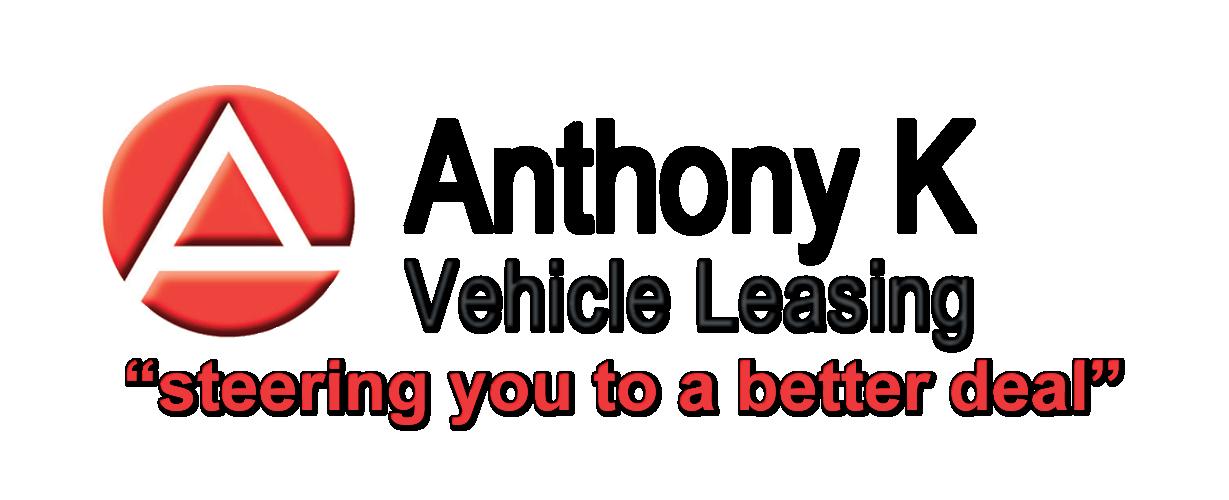





Last year’s predictions for consultant radiologists’ private incomes were far too pessimistic about their profits. Ray Stanbridge reports
There is a lot of talk and gossip right now about developments in the private radiology market. some is quite scary and relates to heavy cuts in fees.
But at the same time, it is suggested that some radiologists are taking advantage of the postCompetition and Markets Authority environment.
Three things were predicted in this Profits Focus last year:
❶ Average income and margins of radiologists in private practice would continue to show a small but noticeable decline; ❷ There would be continuing growth in large practices;
❸ There would be a growth in the number of entrepreneurial radiologists.
Well, it turned out that the actual outcome for 2014 was rather like the Curate’s egg – right in parts, and hopelessly wrong in others.
Consultant radiologists’ private practice fee income actually rose by 17.9% from £95,000 in 2013 to £112,000 in 2014.
Costs rose by 6.9% from £27,000 in 2013 to £29,000 in 2015. As a result, taxable incomes increased by 22% from £68,000 to £83,000.
As in previous years, this
aveRage INCOMe aND eXPeNDITURe OF a CONSULTaNT
Expenditure
income survey is restricted to those consultant radiologists who are not in full-time private practice. To qualify for our survey, they must:
h ave had at least five years’ experience in the private sector;
earn at least £5,000 a year gross from private practice;
Be seriously interested in private practice as a business. This condition effectively excludes most small earners who look to their practices merely to meet school fees or holiday costs;
h old either an old-style N hs maximum part-time contract or a new contract;
Work either as a sole trader through a formal or informal partnership, limited liability partnership or group or a limited liability company.
Market changes
You will all be very familiar with the changes in the market structure since 2008, when this benchmark series started in Independent Practitioner Today
For example, there has been:
A growth in the number of radiology groups;
s ignificant growth in N hs activity in the private sector market – analysts LaingBuisson now estimate that this exceeds 30% of the spend;
i ncreasing direct contractual arrangements between hospitals and radiologists – individually and in groups;
Generally downward pressure on fees imposed by other hospitals and insurers;
An increasing importance of ‘part-time’ as opposed to full-time private practice.
i n addition, some radiologists are, to all intents and purposes, ‘employed’ by local private hospitals.
All these factors have had an impact on the significance of the trend figures we have produced. As a result, while this series never claimed its benchmark figures to be statistically significant, they have perhaps become more and more inaccurate as an ‘average’ and, in some cases misleading, as to what is actually happening in the market.
The caveats are enormous. But let me interpret what i have found. i am surprised at the increase in average incomes. There has unquestionably been some growth in interventional radiology, which has generated activity at higher margins.
The growth of Nhs Choose and Book work has also helped a number of radiologists to boost their private practice incomes.
Source: Stanbridge Associates Ltd.





Would you like to remove the administrative stress of medical billing and collections?

Have you an amount of bad debt owed?




Would you like to raise the profile of your practice and attract more patients?








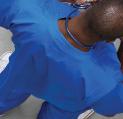












some radiologists have invested – either directly or in co-partnership with hospitals and others – in plant and equipment and they have enjoyed enhanced income as a result.
There seems to be a number of reasons which explain why gross incomes appear to have risen but perhaps not to the extent shown. Perhaps radiologists are working harder and have more activity than in the past.
There seems to be a number of changes in average costs.
For a number of consultants, medical suppliers/assistants fees have reduced slightly – they are
doing the work themselves rather than subcontracting.
s taff costs have risen – a common phenomenon in most specialties. s taff costs, particularly where family members are employed, seem to grow in direct correlation with the growth in personal tax-free allowances.
Other costs seem to be much the same. There are some increases in use of home costs, where radiologists report from home and have a genuine second, or third, business base.
Allowable motor costs appear to
have decreased. This is to be expected as a result of the landmark s amadian case rulings on travel costs, well reported in Independent Practitioner Today Again, this trend is not confined to radiologists.
There has been a slight increase in ‘other costs’. Most, but not all, radiologists have invested in website and marketing costs. There has been an increase in expenditure on conferences and courses, particularly abroad.
What then of the future? i will be careful following the 2014 trends forecast, but i foresee a continued growth in larger practices and groups. They will negotiate collectively with hospitals and also insurers.
And i believe the growth of ‘part-time’ practices will increase among radiologists able to offer a small number of sessions for private practice to fit in with their Nhs and private life schedules.
With the range of influences operating in the sector, we can also expect to see more volatility and definite shift away from the ‘sole trader’ radiologist to the ‘corporate’ consultant.
The big potential for income growth seems to be in interventional radiology and for those who specialise in this area, the future looks rosy.
Make sure you don’t miss our next issue, published on 21 april. Only subscribers to the journal are guaranteed to receive every copy and we don’t think anybody who is serious about continuing private practice in the future, when there is so much happening that will affect them, can afford to miss any issue.
Coming up next month:
Protect your goodwill! Solicitor Lynne abbess of Hempsons shows how
How the Budget will affect you – and what you can do about it
Winning ways with PPUs. Philip Housden’s new monthly series looks at the financial year through the eyes of the life of a private patient unit and gives some handy tips about business development opportunities along the way
Don’t damage your business by using poor case studies for publicity. julia Kendrick highlights five common mistakes
Tips to help you spring clean your finances

Marketing expert Malcolm McCoskery continues his ‘Practice Builder’ series with advice on choosing a private hospital. He says there may still be areas hospital groups can help develop doctors’ businesses
So if you are owed money, how do debt collectors really work? gary Nials reports
In our Business Dilemmas series, the MDU’s Dr Nicola Lennard continues with answers to questions about being notified of a complaint: one from the gMC and another from a newspaper
Pitfalls in private practice. The MPS’s Dr Marika Davies highlights the five medico-legal sins that could potentially cause complaints or claims
For doctors running a business, there’s always one thing that is ticking away at the back of your mind. and that is…the competition. Surgeon Dev Lall has some advice
Breaking into the aesthetic business: Pam Underdown shows how to overcome your ‘fear’ of sales and marketing. Forever.
‘Doctor On The Road’ Dr Tony Rimmer reviews what could be the new default executive small saloon for the independent practitioner –the jaguar Xe
Starting a private practice – the tax changes affecting second homes
Consent for intimate examinations – Dr Richard Brittain of the MDDUS has some useful advice
Financial product warning: doctors should be wary of anything that looks too good to be true
aDveRTISeRS: The deadline for booking advertising for our april issue falls on 29 March
eDITORIaL INqUIRIeS
Robin Stride, editorial director
Email: robin@ip-today.co.uk
Tel: 07909 997340
aDveRTISINg INqUIRIeS
Margaret Floate, advertising manager
Published by The Independent Practitioner Ltd. Independent Practitioner Today is editorially independent and thanks Bupa for its assistance with distribution.
Printed by Pepper Communications Ltd
Material is governed by copyright. No part of this publication may be reproduced, stored in a retrieval system or transmitted in any form without permission, unless for the purposes of reference and comment. Editorial layout is the copyright of the publishers. If you wish to use it for promotional purposes on websites or for reprints, we would be happy to discuss licensing the copyright to you.
© The Independent Practitioner Ltd 2016
Registered office: 7 Lindum Terrace, Lincoln LN2 5RP Write to
Email: margifloate@btinternet.com Tel: 01483 824094
Publisher Gillian Nineham Tel: 07767 353897. Email: gill@ip-today.co.uk
SUBSCRIPTIONS
£90 independent practitioners.
£90 GPs and practice managers (private & NHS). £210 organisations.
But if you pay by direct debit, individuals pay only £75, and organisations £180 Call Proact Ltd on 01752 312140
Email: lisa@marketingcentre.co.uk



To guarantee your copy of Independent Practitioner Today by taking out a subscription (at the rates shown on the left), phone 01752 312140 or send off a subscription form on page 28 or email lisa@marketingcentre.co.uk or go to the ‘about’ page of our website www.independent-practitioner-today.co.uk
If you pay by direct debit, individuals pay only £75 for a subscription. just fill in the form on page 28 and send it to the Freepost address shown at the bottom of the form.
BaCK ISSUeS: £12.50 including post & packaging
CHaNgINg aDDReSS OR SUBSCRIPTION DeTaILS?
Phone 01752 312140 or email lisa@marketingcentre.co.uk
Membership enquiry is one of my favourite features and a real time-saver. By quickly checking patients’ insurance details online, I can ensure my invoices are correct and avoid delays.
Kate Wilkinson, Medical Secretary

Healthcode’s ePractice solution provides a standard database to manage and hold your patient information. The patient database includes patient flags, identifiers, notes and alerts. ePractice patient correspondence gives you built in letter templates and the option to create your own letters.
Using ePractice to manage your patient database, you can:
• Access patient records from multiple treatment sites
• Store patients’ personal and contact details

• Easily view patient notes and alerts
• Use built in letter templates & store communication with patients
• Confirm patient’s insurance and demographic details
• All data is held securely in the UK
Healthcode’s ePractice solution offers:
Patient Billing
Patient Management
Payment Tracking & Financial Reporting
Appointments
Membership Enquiry
Complimentary ePractice App Experts in Online Solutions for Smarter Healthcare... ‘code for success.